Learning and Teaching
- Assessment & Feedback

How to mark an Assignment online in Moodle
Preparing to grade an assignment.
Before beginning marking it’s important to understand how your assignment has been setup, so that you can ensure that you are not showing marks and feedback to students before you are ready for them to see them .
By default, Moodle assignments hide grades and feedback from students through the ‘Marking Workflow’ option.
When you create an Assignment, the ‘Marking Workflow’ setting will be enabled. This automatically hides any marks and feedback that you upload for students until you take specific steps to release the marks and feedback. This is a ‘safer’ option for the requirements of most Teachers .
Guidance on releasing Marks and Feedback, and sending a notification to students with a few clicks, using marking workflow can be found below.
If you prefer instead to turn off the marking workflow option you can do so within the Assignment’s settings, under the ‘Grade’ settings. Note that doing this will mean that any marks and feedback added to Moodle will be immediately visible to students!
If you have turned off Marking Workflow, but you also don’t want students to see marks and feedback as soon as they are uploaded, you will need to hide the Assignment link and Gradebook item until you are ready to reveal the marks and feedback.
The guidance below shows how to turn off Marking Workflow (if you wish) and how to hide the Assignment link and Gradebook item:
- Find your Assignment and select Settings
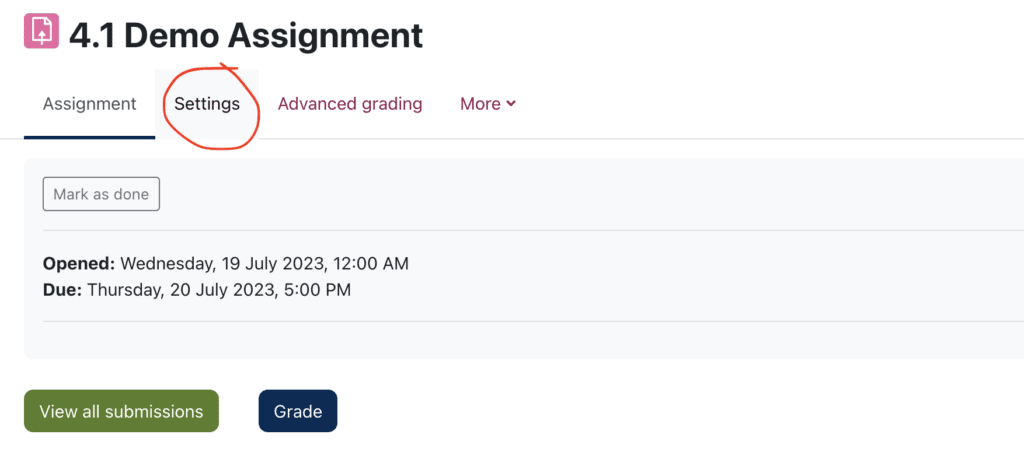
- Scroll down to ‘ Grade ’ settings and expand them
- Set use marking workflow to no
- Save changes
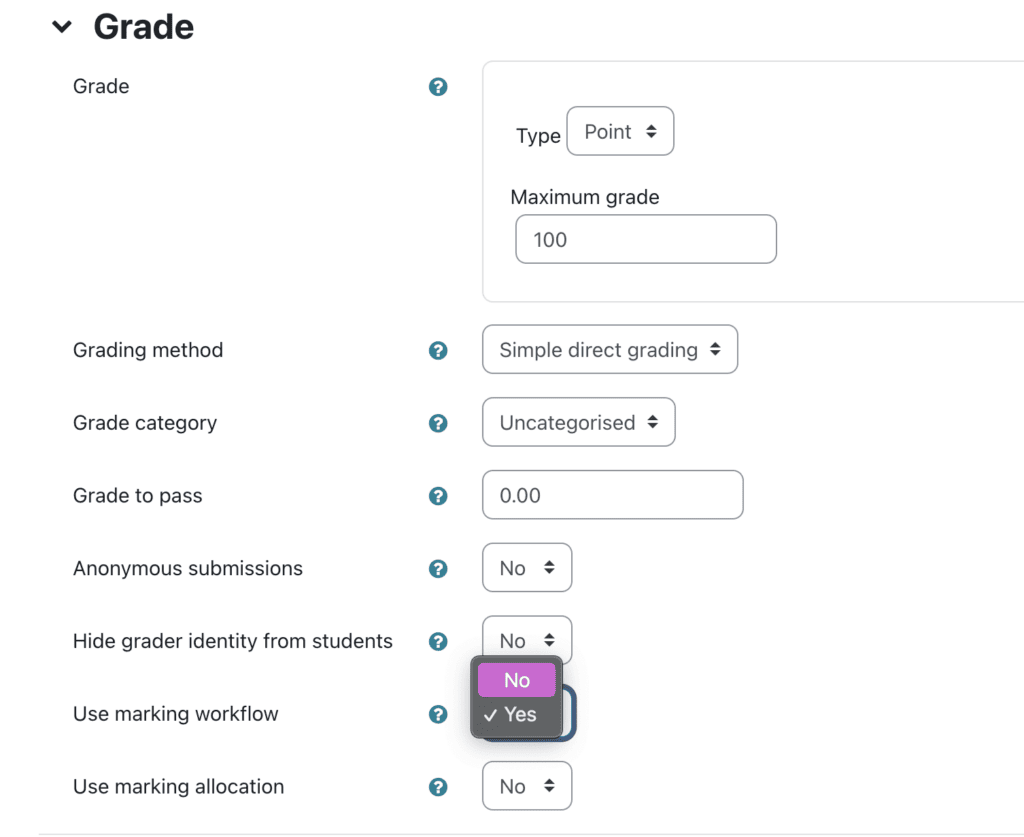
Note: Any marks and feedback you add will now be immediately visible to students!
To manually hide marks and feedback from students you will need to hide the Assignment’s Gradebook item and the Assignment link (which is often not practical where there are late submissions)
To hide the Gradebook item:

- Go to the Course Homepage and choose the Grades tab
- From the Grader Report drop-down menu, choose Gradebook Setup .
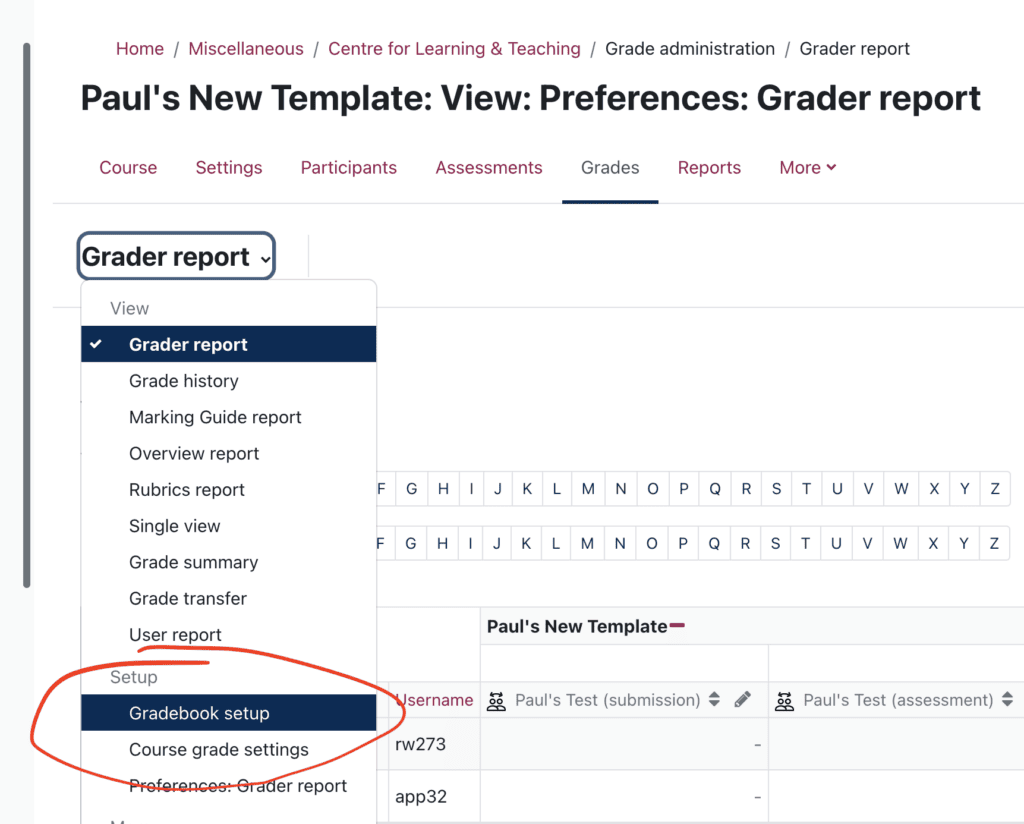
- In the row for the Assignment that you wish to hide, in the Actions column, choose Edit then Hide .

- Save Changes .
- The Gradebook item will now appear to be greyed out to show that it is not visible to students.

To hide the Assignment link from students:
- Navigate to the Assignment and, from its Edit drop-down menu, choose Hide .

- You can now begin marking.
Note : When are ready to release marks and feedback to students, don’t forget that you’ll need to make the Gradebook item and Assignment link visible again.
Lock submissions to prevent changes
Before you begin marking it’s a good idea to lock submissions. This will prevent students from making any changes to their submissions once marking is underway. To do so, navigate to your Assignment and View all submissions .
- Tick the box at the top of the ‘select’ column to select all user submissions.
- From the ‘ With selected…’ drop-down menu choose Lock Submissions .
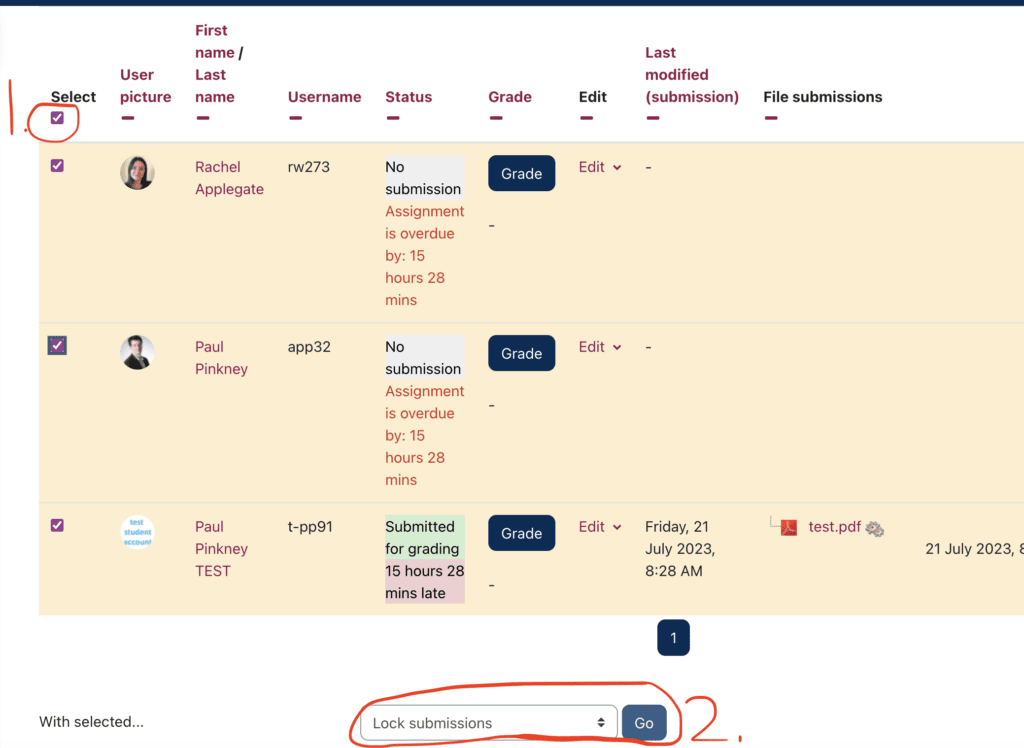
Note: If you have a large number of students you will need to select the option under the table to ‘show all students on one page’.
Moodle grading interface overview
Moodle has a built-in grading interface that allows you to annotate student assignments, add summary comments and award marks. Student submissions are displayed in PDF form and include a link to the Ouriginal similarity report (where activated).
The image below gives an overview of the built-in grading interface:
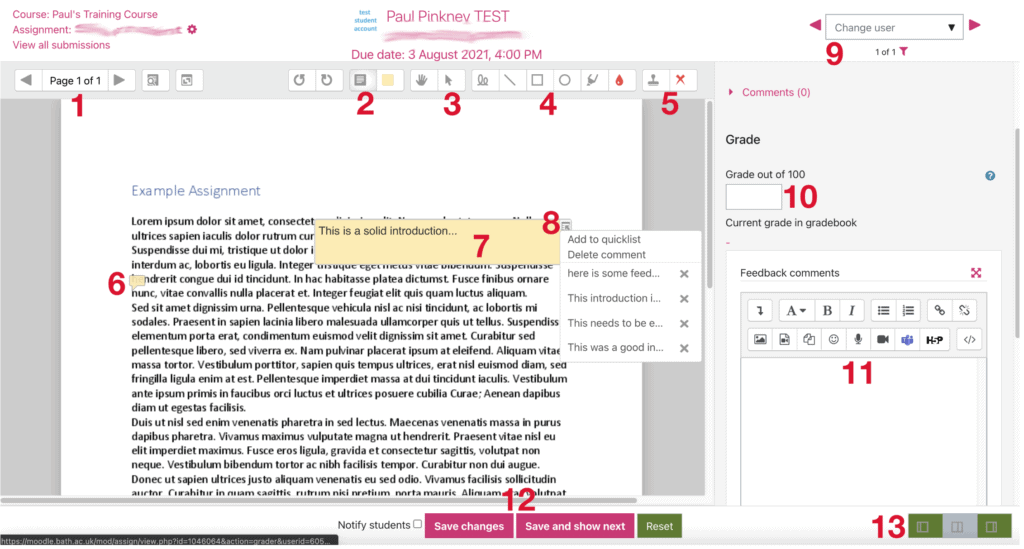
- Use the next and previous arrows to move to the next page of the student’s document or choose a page from the drop-down menu.
- Add an annotation to comment (with option to choose background colour).
- Use the arrow tool to select, move or delete existing annotations.
- Other tools such as the pen (squiggly line) for free form drawing or writing, shape tools, line, highlighter)
- Stamp tool/x tool.
- Anchor for an annotation (if you hover over it, it expands to reveal the annotation)
- An annotation
- Click the sub-menu icon in annotation (top right corner) to delete or add annotation to a ‘quicklist’ for the assignment).
- Use navigation to see Previous/Next student’s assignment or filter.
- Add grade here in the right-hand pane.
- Summary feedback can be entered here
- Don’t forget to save any changes made!
- Click to cycle through the options for screen layout
The video below provides an introduction to the grading interface, shows how to annotate student scripts, view Ouriginal reports and award marks. It also details how you can lift anonymity (where anonymous marking is being used) at the end of the marking process.
Marking Assignments Online
Marking a Group Assignment
Where one student has uploaded a file on behalf of her Group, the file will appear against all Group members, and any of these can be marked. On the individual student grading page, an option to ‘ Apply grade and feedback to all members of group ’ will appear. If ticked the grades and feedback will be applied to all group members.

Allocate Assignments to another Marker
You can use the Marking Allocation feature to assign student submissions to a specific marker in your Moodle space.
- Marking allocation – this allows allocation of markers to work after the deadline. Marking allocation depends on Marking workflow being enabled.
Marking Workflow and Marking Allocation must be enabled in your assignment settings.
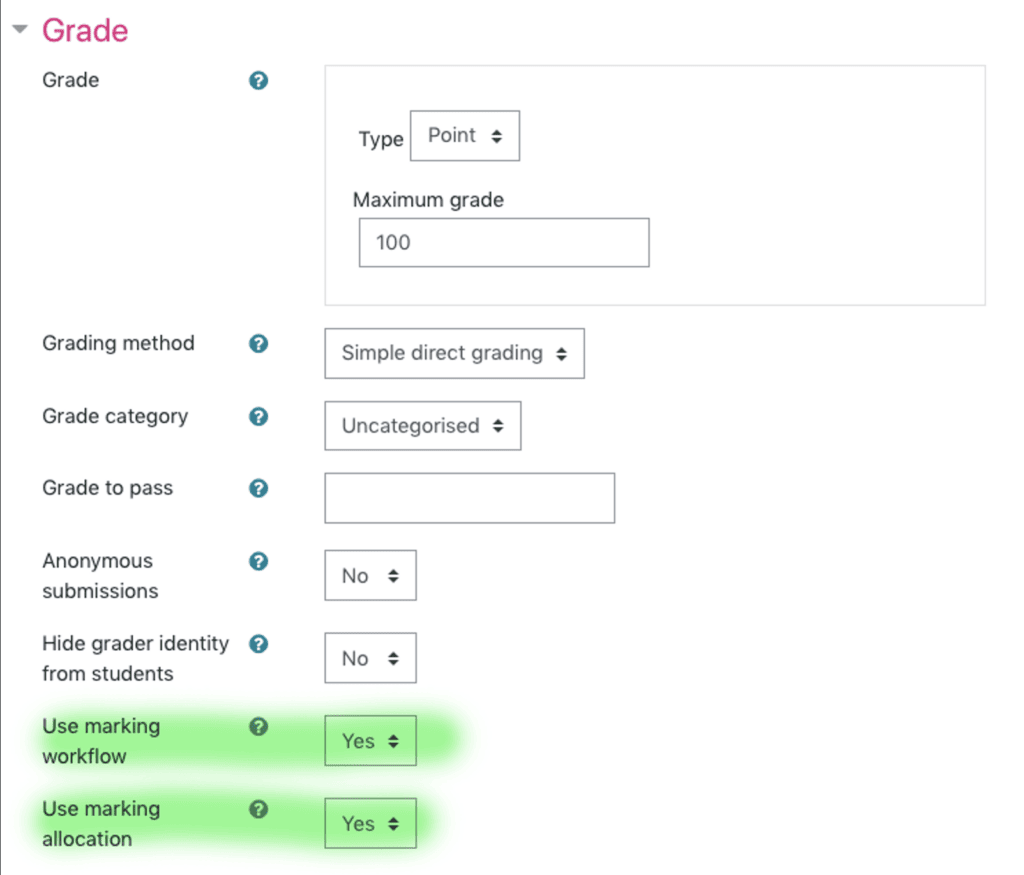
Once these have been enabled, you can allocate assignments to a marker.
- Click on your Assignment link
- Click on View all submissions

- Tick the box to the left of the student whose assignment you want to allocate, then choose Set allocated marker and click Go .
- At the prompt click Ok , then on the next page select your allocated marker from the drop-down menu and click Save Changes .
How to lift anonymity in an Assignment
If you are using Anonymous Marking (blind marking) in Moodle, once you have completed marking, it is necessary to lift anonymity in order to release grades to the Gradebook. Please note that lifting anonymity can only be done once, (you cannot return the assignment to an anonymous state once it has been lifted), so ensure that you have completed all marking before going ahead.
To lift anonymity.
- Click on the assignment link, then click on View all submissions
- From the grading actions menu choose Reveal student identities:
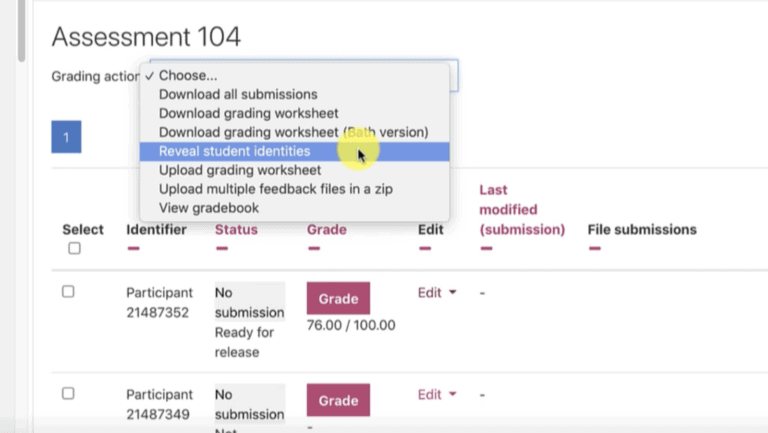
This video also shows the process for lifting anonymity: https://uniofbath.cloud.panopto.eu/Panopto/Pages/Viewer.aspx?id=dbdb18a7-e4f2-40af-a7fe-acd800a3803c&start=0
Lifting Anonymity
Related Articles
- Anonymous marking in Moodle
- Advanced Grading in Moodle
- Group Peer Review for Teachers
- How to mark an Assignment offline and upload feedback
- Using Ouriginal
- How to create an Assignment
Article Contents
Moodle 101: How Does Moodle Grading Work?
Confused about Moodle Grading? In the teaching and learning process grading is an essential component since it informs both students and teachers of their progress in terms of level and provides feedback on the efficiency of the teaching strategies and study aids employed.
Grading activities is an important part of your job as a teacher, but it may be a time-consuming activity. Making grading easier will help you finish other items on your to-do list and save time so you can focus more on planning for future classroom events.
A variety of Moodle activities can be graded (an activity must first be configured as graded). Once a student submits an assignment, the teacher can immediately enter the marks, assessment, or grade to the student from the same activity, and the result is automatically added to the grade book. A column in the gradebook is automatically created for each activity that has been graded. New columns can be manually created and filled with grades and marks.
If there is one feature that distinguishes Moodle, it is the numerous options for creating tests and assessments. Instead of using a grading method just because it is available, it is important to know why you should choose one over the other. The idea here is to create a plan and implement it in Moodle. The platform serves as a tool to help you meet your learning objectives in this way.
Similarly, Moodle provides an essential set of tools for assessing, grading, and evaluating. This means that there are very few platforms capable of competing with Moodle. So, keep this in mind to ensure that you can apply the strategy that best satisfies your objectives.
The Moodle Gradebook: How to Get Started
Your Moodle course assignments, tasks, and/or manual grades are automatically compiled into a single score and piece of feedback in the Moodle Gradebook. Students can check their grades in personalized reports that safeguard student privacy. The gradebook may be displayed to students at certain times and in certain ways, or the instructor may completely hide it.
It is possible for teachers and teaching assistants to manually input and amend grades in the gradebook, and import grades from external sources such as OWL, iClicker, and Opscan. Or export the gradebook to another software program like Excel.
Moodle keeps track of all gradebook modifications so that instructors can verify who made what changes and when. Based on the instructor’s assigned grading scale, the gradebook keeps track of each student’s overall course grade.
Setting Up the Moodle Gradebook
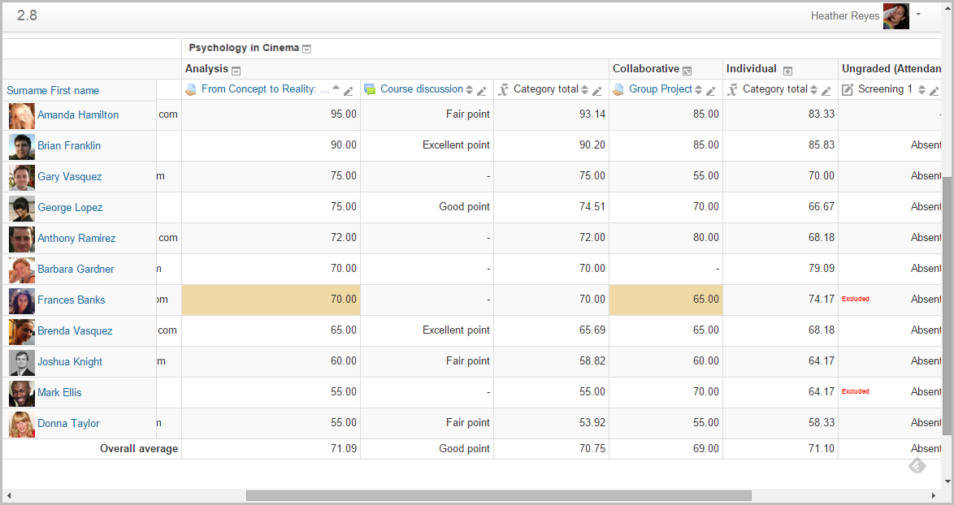
The Moodle gradebook offers a number of features and functionalities that will assist you in navigating to the locations where you need to be in order to do the activities you desire. The gradebook offers a variety of choices for calculating and displaying grades. Your gradebook can be set up in advance of the semester or created as you go.
Setup and Organize Grade Items and Categories
The course gradebook in a Moodle course automatically adds matching grade items (columns) when activities like Assignments or Quizzes are uploaded. In order to record more grade components, Moodle also allows you to manually add columns to your gradebook. It is acceptable to create your gradebook as you go in both of these scenarios, but when it comes to determining final grades, the organization of these factors is necessary to guarantee accuracy.
Calculating Grades
Allowing Moodle to handle calculations is the simplest approach to determining grades. If you need subtotals, Moodle includes built-in computations (aggregations) to figure out the grade for the entire course.
When accrediting grades, Moodle offers three options:
- Natural – the total of all grade values.
- Mean of grades – the total of all grades divided by the total number of grades.
- Custom weights – where weights are assigned as a proportion of the overall grade to certain items or categories.
If you need more operations, you could also make a special formula.
Rubrics and Non-numerical Scales for Grading
Some Moodle activities offer to grade using rubrics and non-numeric scales if you prefer alternate techniques for reviewing student work.
Rubrics are helpful when you want to evaluate student work based on a variety of criteria. When evaluating Assignment activities, you can set a rubric and criteria using advanced grading options, and the rubric will produce an overall grade.
Custom Scales are useful when you want students to view Excellent, Good, Fair, and so on as a grade on an item rather than a numerical number. While non-numeric assessments can be displayed using bespoke scales, the gradebook will still be able to do computations with these items if necessary.
Display Grades in Percentages And Letters
You can choose to display grades to students as a letter, a percentage, or a numeric number by modifying the settings in your gradebook. The Grade type of Points is used by default in Moodle activities, with a maximum grade of 100.
You can alter grade limits on the gradebook Letters tab by matching score ranges to letter grades (e.g., 93.00-100.00 for A). Following that, when grading, input the number that corresponds to the letter grade you want to give (for example, 90 for a B+). Students will see the right letter grade when Moodle generates letter grades since it compares numerical scores to the ranges in the Letters settings.
Although, only numerical scores may be recorded for grade elements connected to Moodle activities. For Moodle in the Cloud, it is no longer possible to manually grade items in Moodle by entering letter grades. Letter grades can be shown to students as a percentage, but instructors must record or import grades as points.
Edit The Activity Name of Every Column In The Gradebook
A new column will be automatically created in the gradebook for a Moodle activity after it has been configured to be graded. The column will have the same name as the activity. If the name is lengthy, only the first 12 characters are shown as the column name. Therefore, it is advised that you give the activities short, distinct titles.
New columns can be manually created and filled with grades and marks. Instead of establishing a new column and entering the results, if at all possible, think about using an assignment.
As you add the graded activities to the course, columns are created in the gradebook to reflect this. For this reason, it is frequently required to afterward arrange the columns in the proper sequence. It is fair to establish categories (from chosen columns) and sort columns into categories if there are several graded activities in the course.
Setting Up An Automated System To Verify For Passing Grades
The learner’s performance can be automatically checked to see if it complies with standards using the gradebook configuration options.
For instance, if all of the assignments have been passed (marked on a pass/fail scale) and the average of all quizzes is at least 80%, the course is considered passed if graded using the 10-point scale. Or the course grade is a letter grade determined by the points earned, but it is only considered successful if the learner has passed all non-differentiated examinations.
A formula can be used to determine the passing grade. The formula is dependent on the display type and the configuration of the course’s total grade
Prepare The Final Grades
You can easily shift grades from the Moodle gradebook to your SPIRE grade roster at the end of the semester. Using a scale of your choice, Moodle will convert numerical grades to letter grades. You can still change grades after importing them into SPIRE before the Registrar approves and receives them.
How Does Grading Work With Moodle?

The gradebook automatically compiles the results of graded Moodle activities. Entries in the gradebook are always numeric so Moodle can simply aggregate grades automatically.
Although this can be changed in the Assignment options for each activity, the default rating for each activity is 100. The weights of individual assignments or groups of assignments can then be adjusted in the gradebook to get the overall grade for the class.
You can create a grading system and use it to display letter grades to students based on percentage. Grading can be fairly simple if you use Moodle techniques. It is possible to grade using your own procedures, although it can necessitate additional processes and workarounds.
Some tasks, like the Turnitin and Moodle assignments, let you apply a rubric or grading form to determine your grade.
Manually added grade items (with the exception of Moodle activities like quizzes or assignments) can be adjusted to allow you to type or import actual letters if you choose to grade exclusively using letters and do not want to enter numerical values. It should be noted that using this method excludes the use of numerical scores and prevents Moodle from calculating an overall course grade.
You can give feedback on the majority of Moodle activities using a (verbal) Scale that includes terms like “outstanding,” “unsatisfactory,” and “satisfactory.” It should be noted that each custom scale value has a number associated with it, so you should consider how those numbers will combine to determine a course’s overall grade.
Students can view written feedback next to their grade if you add it. When grading from within the activity, some activities (including Assignments, Turnitin assignments, Quizzes, and Workshops) have a place for writing written feedback. The gradebook also allows you to add comments for graded objects.
How to Grade your Moodle Assignments: 3 Methods
There are three options for grading systems in the Moodle assignment activity in addition to the standard options like points and scales. “Simple direct grading,” “marking guidelines,” and “rubric” are the three options.
Simple Direct Grading
Simple Direct Grading is by far the simplest to implement. When you create an assignment, this is the default setting. You have the choice of giving an overall score and overall feedback when grading a submission. Even though the simple direct way of grading is straightforward, it depends on the feedback remark box as the main tool for informing students of their areas of strength and weakness in the assignment.
The rubric is precisely what it says it is. In your course, you can create a rubric that you can use to grade tasks in Moodle. You will be taken to a screen where you can either start generating a rubric from the beginning or modify the one you have already established as a template once you choose the rubric technique and save your assignment.
When using a rubric to grade work, you can enter feedback at the appropriate criterion level by clicking on the level the student has achieved. If you want to have an area for feedback on the entire assignment or remarks not covered by the rubric, there is also a spot for an overall feedback comment.
Marking Guide
The Marking Guide functions as a halfway point between the rubric and simple direct grading. The marking guide approach enables the mark to be broken up into criteria while still providing direct grading boxes for each criterion, as opposed to having the criteria and levels of the rubric method.
There is a feedback box for each requirement in your marking guide, as well as a direct grading box that allows you to enter the student’s level and your chosen point total.
Final Thoughts On Moodle Grading
Moodle is an extremely adaptable learning platform that lets you select or combine several grading techniques. Grading can be quite simple if you follow the Moodle guidelines. It is feasible to grade using your own procedures, although it can necessitate extra steps and hacks. As you grade on Moodle, we hope that some of these thoughts will be helpful.
Looking to take your Moodle course to the next level? Whether you need some help selecting and configuring new plugins, designing your site or something more complicated, our team of Moodle experts is here to help.
Don't forget to share this post!
Elena Gutierrez

Everything You Need To Know About Membership Pricing Strategy

The secret to better course content: Integrating H5P with your WordPress LMS

LearnDash vs Kajabi: Choosing the Right Online Course Platform
Cancel reply, download e-book.


Swarthmore College – ITS Blog

Grading Assignments in Moodle with the Built-in Annotation Tool
Using the built-in assignment grader tool.
Did you know new improvements have been made to Moodle’s built-in Assignment Activity grading interface? The new interface will convert student submissions to PDF so that you can view and annotate assignments on your desktop in addition to entering grades and feedback.
The built-in grading function in Assignments allows the grader to:
- Make annotated comments directly into the file, which Moodle automatically converts to a pdf
- Give short, general comments in the Feedback Comments text box
- Upload feedback files into the proper feedback box
- Grade the submission
Using the Built-in Annotation Tool
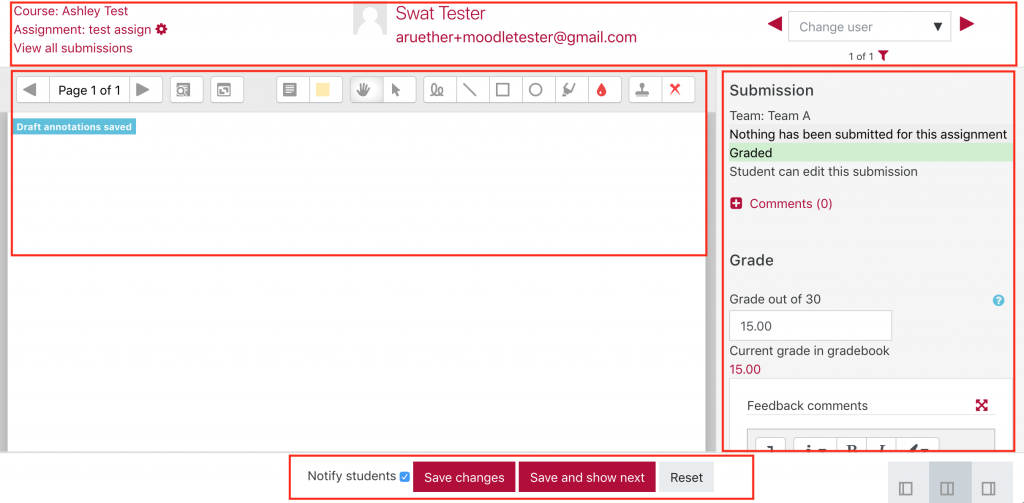
The top left of the banner allows you to navigate back to the course site page or assignment description page. The top center displays the current student’s name and email information. The top right of the banner allows you to navigate to other student submissions.
Right Column
The right column of the annotation tool displays a link to the assignment submission file in its original file format. It also contains a feedback comments text box, and the feedback files upload box.
Center Area
The center area displays the PDF document to be annotated. Use the annotation toolbar to mark up the submitted PDF document. You can use the highlighter, comment box, and pen tool from the top menu bar.
Footer Area
At the bottom of the screen there are three options: Notify Students, Save, and Reset.
- Notify students will send the current student an email notifying them that their assignment has been graded. Uncheck this box if you do not want the student to receive a notification
- Save changes is required to complete grading the assignment of the current student selected
- Reset will clear all feedback comments
If you’d like to learn more about the different ways to grade Assignments in Moodle take a look at the video below. Or feel free to reach out to the Academic Technologist team at [email protected] . We’d be happy to go over this tool or any other Moodle question with you at anytime.
Share this:

Moodle Marking Types
In Moodle, there are 3 primary methods in which teaching staff can mark graded student submissions, these include:
- Simple direct grading
- Using rubric
- Using marking guide
Different grading methods
Simple direct grading is the most straightforward and simple method to understand and set up. As teaching staff begin to mark submissions, they can manually provide a numerical mark, no other steps are required. When the grader provides only a final grade and feedback to students, is the most commonly used grading method for a Moodle Assignment.
Rubrics or marking guides are recommended for high-stakes tasks, but simple direct grading is great for smaller assignments. It takes very little time to set up and enables grading assignments quickly using the quick grading function.
Marking with a rubric allows teaching staff to address several aspects of a student's assignment and assess them separately. Moodle will calculate the total aggregated grade from all the addressed aspects/criteria. Rubric marking makes the rationale behind the scores clear to students and to other markers of the same assignment. Rubrics can be time-consuming to set up as all criterion scores and descriptions must be created alongside the rubric.
A marking guide is very similar to a rubric, but it's simpler. For each marking criterion, a comment explains what is being sought, and provides a maximum mark that can be awarded.
Marking using a marking guide is more detailed and less subjective than awarding a single grade, but it's less time-consuming to set up. Students can be allowed to view the marking guide before they submit, so that they know what their learning priorities are in relation to this assignment.
Marking guides and rubrics are forms of standards-based assessment. Click the following link to find out more about standards-based assessment .
Set activity with simple direct grading
By default, all activities are set with simple direct grading. These settings can be found in the "Grades" tab of the Settings page of any gradable activity.
Click ' Get Started' to view the step-by-step guide
Set activity with a rubric
A rubric is a set of marking criteria, for each of which several descriptive levels are defined and assigned points. It is presented as a table, with the criteria defined in rows and the levels and associated points defined in columns.
Mark a rubric graded activity
Activities that are set up with Rubric grading method are marked slightly different that direct grading method ones.
Set activity with a marking guide
A marking guide is a simpler form of rubric, which can also be created within Moodle.
Mark a marking guide graded activity
Grading activity that is set up with a marking guide is very similar to an activity with rubric, however, there are some differences. Marking guide allows to leave additional feedback for each criterion student is being graded with. Also, it allows to specify the grade out of the maximum allocated grade points.
How to edit rubric?
Rubrics can generally be edited up until they are used.
Issues can occur in Turnitin as old rubrics cannot be edited after they are used unless they are duplicated.
Create a duplicate of the rubric
Make changes to the duplicate in the Rubric Manager
Attach the new rubric to the activity.
If the activity has a previously attached rubric, attaching a new rubric may result in a loss of content
How to duplicate rubric?
Instructors can duplicate rubrics from the rubric manager in the activity’s settings.
Click ‘Launch Rubric manager’ in the activity’s settings
Select your rubric in the top left menu
Click ‘Duplicate this rubric’ in the top left menu
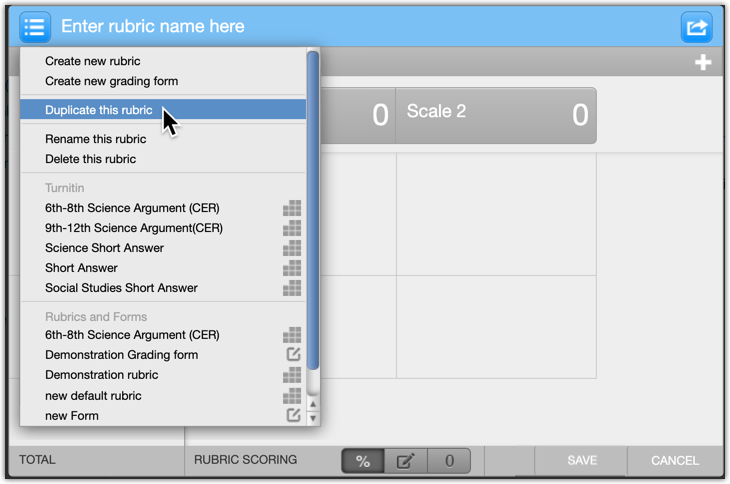
On this page
- Account creation and closure
- Account management
- Two-factor authentication
- Computers and Phones
- Email and Calendar
- File Storage
- Internet Connections
- Other Tools
- Printing, Copying, & Scanning
- Accessibility
- Devices: College-provided
- Devices: Personal
- Installation
- Microsoft 365
- Off-Campus Access
- Domain of One's Own
- Visitor accounts and access
- College password: Set up and update
- Get started at Bryn Mawr
- Leaving Bryn Mawr College
- BMC Off-Boarding Computing Checklist
- BMC On-Boarding Computing Checklist
- Group Manager: Grant and revoke access
- LITS Service Catalog: View project requests
- BIONIC: Data standards for names and more
- BIONIC: User interface guide
- BIONIC: View budget reports
- Encryption: College-Owned Computer (macOS)
- Encryption: Emails in Microsoft 365
- Encryption: External Storage Drives
- CrowdStrike Falcon Antivirus: Overview
- International travel: technology and security
- Malware and spam: Phishing emails
- Malware and spam: Ransomware
- Password managers
- Password safety: Best practices
- Two-Factor: Get started with Duo
- Two-Factor: Methods of Authentication
- College computers: Accessibility settings
- College Deskphone: Setup & Use Updated
- College Softphone: Setup & Use Updated
- Common hardware issues
- Help Desk tickets
- LITS's Device Support Cycle
- New College computer? Start here!
- Standard computers and accessories
- Remote Learning, Teaching, and Work: Suggested Computer Accessories
- Shipping Devices to LITS
- Students: Laptop Purchasing Guide
- Students: What tech to bring to College
- Alumnae/i: Email Forwarding
- Microsoft Outlook: create accessible emails
- Mailing Lists: Management
- Mailing Lists: Overview
- Microsoft 365: Overview
- Microsoft 365: Shared Email, Calendars, and Folders
- Microsoft 365: Export Emails
- Calendly: Schedule appointments
- Outlook: Schedule Zoom meetings through Outlook
- Data backup: Why, where, and how
- CrashPlan: disaster recovery
- Data Clean-Up: Email Inbox
- Data Clean-Up: Storage Drives (C:, H:, S:, Q:, and more!)
- Network Drives: Connect from Windows or macOS
- OneDrive: Share files and folders
- Save a file as a pdf
- Eduroam: Connect to College Wifi Updated
- Ivanti Secure VPN: Off-Campus Access
- Gaming Wi-Fi: Connect your devices
- Network Registration
- Moodle: Log in
- Moodle: Courses Not Showing Up
- Moodle: Browse courses during registration
- Moodle: Use the text editor
- Moodle: Add files and folders to a course
- Moodle: External tool connections
- Moodle: Add course blocks
- Moodle: Manage Class Recordings with Panopto
- Moodle: Schedule class Zoom meetings
- Moodle: Enable students to schedule appointments
- Moodle: Add JoVE content to a course
- Moodle: Restore recently deleted items from the recycle bin
- Moodle: Link to McGraw-Hill
- Moodle: Link to a Cengage Platform
- Moodle: Customize and organize your course
- Zoom: Schedule course meetings with the Moodle Zoom activity
- Moodle: Hide and unhide courses and course sections
- Moodle: Copy content from another course
- Moodle: Get a merged Moodle site for a multi-section course
- Moodle: Save or export course data and content
- Moodle: Set up a course gradebook
- Moodle: Hide grades from students
- Moodle: Extensions, overrides, and accommodations
- Moodle: Download assignment to grade offline
Moodle: Grade assignments with Annotate PDF
- Moodle: Use grading workflow to manage assignment feedback
- Moodle: Make an assignment extra credit
- Integrations
- Moodle: Create and manage assignments
- Moodle: Use the Calendar
- Moodle: Convert documents using Sensus Access
- Moodle: Create and grade Quizzes
- Moodle: Use Question Bank
- Moodle: Forums
- Moodle: Create a questionnaire
- Moodle: Student Journals
- Moodle: Workshop
- Moodle: View Course Evaluation Results
- Moodle: Add or change your photo
- Moodle: View and submit assignments
- Moodle: Take online quizzes and exams
- Moodle: Participate in a workshop activity
- Moodle: Export coursework and materials
- Moodle: Complete Course Evaluations
- Moodle: Instant Messaging
- Moodle: Get accessible alternative formats for course materials
- Moodle: Enroll or unenroll participants
- Moodle: Using Groups
- Moodle: Message course participants
- Moodle: Take attendance
- Moodle: Guest access to courses
- Moodle: View course as a student
- Moodle: Create checklists for students
- Constellate: Log In and Authenticate
- LinkedIn Learning: Overview
- LinkedIn Learning: Create and share playlists
- Macmillan (Achieve, LaunchPad): Link to Moodle
- NameCoach: Overview
- NameCoach: Add name recording to email and social media
- NameCoach: Add to a Moodle course
- NameCoach: Record and listen to names in Moodle
- NameCoach: Name Pages for events New
- Perusall: Add social annotation assignments to Moodle
- Piazza: Alternative Discussion Tool for Moodle
- Posit Cloud: Teaching with Posit Cloud
- Panopto: Get and log into your account
- Panopto: Training and learning resources
- Panopto: Record lecture using desktop app
- Panopto: Record in your browser (Panopto Capture)
- Panopto: Upload audio or video files
- Panopto: Share recordings
- Panopto: Where are my recordings?
- Panopto: Edit videos
- Panopto: Captions
- Panopto: Add the Panopto block to a Moodle course
- Panopto: Copy recordings to a new course
- Panopto: Collect audiovisual assignments
- Panopto: Student guide to uploading and recording videos
- Panopto: Quizzes
- Panopto: Enable video downloads
- Panopto: Get emailed when videos are posted
- Panopto: Record with multiple cameras/video sources
- Panopto: Department folders
- WeVideo: Create an account on Bryn Mawr's license
- WeVideo: Create and add people to projects
- WeVideo: Video and podcast editing basics
- WeVideo: Finish and share videos
- WeVideo: Add subtitles to a video
- WeVideo: Access after you leave BMC
- Remote learning, teaching, and work: Suggested computer accessories
- Remote teaching: Create digitally friendly documents
- Students: Remote learning tools
- Canon supplies: Order, install, and recycle
- HP supplies: Order, install, and disposal
- Making accessible scans
- Office Lens: Scan papers or documents with your smartphone
- Print from a public printer
- Print with a departmental printer
- Scan and copy with printers
- ABBYY Fine Reader: complex OCR
- Adobe Acrobat: Make PDFs accessible
- Beeline Reader: Make web reading easier
- Sensus Access: Convert documents using Sensus in a Moodle course
- Adobe Creative Cloud: College Computers
- College Computers: Software configurations Updated
- College Computers: Request software changes
- Adobe Creative Cloud: Personal Devices Updated
- Microsoft Edge: Automatic Sign-in
- Software for Personal Devices Updated
- ChemDraw: Installation
- Mathematica and Wolfram|Alpha Pro
- OnBase: Installation Updated
- Software Center: Install Programs Updated
- Microsoft Office: Personal Devices
- Microsoft Office: Public lab computers
- Microsoft Word: Create accessible documents
- Microsoft Outlook: Accessibility features
- Office365: Immersive reader accessibility features
- PowerPoint: Create accessible slides
- PowerPoint: Turning on subtitles
- Apporto: Remotely Connect to a Virtual Lab Computer
- Financial Edge: Off-Campus Access
- LabStats: Remotely Connect to a Lab Computer
- Microphone not working
- Microsoft Teams: Overview
- Microsoft Teams: Accessibility Features
- Zoom: Activate and log into a BMC account
- Zoom: Am I using A Bryn Mawr Zoom account?
- Zoom: Schedule meetings
- Zoom: Schedule meetings through Outlook
- Zoom: Schedule class meetings through Moodle
- Zoom: Host a meeting
- Zoom: Participate in a meeting
- Zooming in less-than-ideal circumstances
- Zoom: Security
- Zoom: Use registration to secure meetings
- Zoom: Where are my recordings?
- Zoom: Breakout rooms
- Zoom: Captions
- Zoom: Chat, reactions, and polls
- Zoom: Increase caption and chat font size
- Zoom: Mirror an ipad in a classroom
- Zoom: Multiple cameras
- Hosting Large Online or Hybrid Events New
- Domain of One's Own: Get started
- Domain of One's Own: Install applications
- Domain of One's Own: WordPress
- Domain of One's Own: Grav
- Domain of One's Own: Omeka
- Domain of One's Own: Scalar
- Domain of One's Own: Log into and manage applications
- Domain of One's Own: Upload and manage files
- Domain of One's Own: Migrate content when you leave Bryn Mawr
- Domain of One's Own: TRU Collector/Writer Sites
- Drupal - Basic: Drupal Training Videos
- Drupal - Basic: Log in and find content in Drupal
- Drupal - Basic: Announcements in Drupal
- Drupal - Basic: Events in Drupal
- Drupal - Basic: Biography Listings in Drupal
- Drupal - Basic: Edit Biographies in Drupal
- Drupal - Basic: Embed forms and other content in Drupal
- Drupal - Basic: Flexible Content in Drupal
- Drupal - Basic: Flex Basic WYSIWYG
- Drupal - Basic: Flex Basic 2 - Accordion, Carousel and more
- Drupal - Basic: Images in Drupal
- Drupal - Basic: News Articles in Drupal
- Drupal - Basic: Pages in Drupal
- Drupal - Basic: Preparing Images for the Web in Adobe Photoshop
- Drupal - Basic: Preparing Images for the Web in MS Word
- Drupal - Basic: Tables in Drupal
- Drupal - Basic: Upload and Link to Documents in Drupal
- Drupal - Basic: Website Image Size and Format Guide
- Drupal - Basic: What is a Web Steward? Roles and Permissions Explained
- Drupal Basic - Introduction to Drupal Drafts
- Drupal - Intermediate: Flex Intermediate A - Columns, Gallery and more
- Drupal - Intermediate: Flex Intermediate B - People List, Features and more
- Drupal - Intermediate: Videos in Drupal
- Drupal - Advanced: Bulletin in Drupal
- Drupal - Advanced: Flex Advanced - Syndication and Flex Items
- Drupal - Advanced: Flex content for special roles
- Drupal - Advanced: Themes and Theme Switcher
- Drupal Short Sessions - Syndication
- Drupal Short Sessions - Event 3up
- Drupal Short Sessions - Announcement 4up
- Drupal Short Sessions - News 3up and News+Contact
- Drupal Short Sessions - Story 1-up and Story 3-up
- Drupal Short Session: Image-based Features in Flex Content
- Drupal Short Session: Image List
- Drupal - Special Role: Admissions Officers in Drupal
- Drupal - Special Role: Course listings in Drupal
- Drupal - Special Role: CV Upload via Provost in Drupal
- Drupal - Special Role: Homepage content in Drupal
- Drupal - Special Role: Navigation Menus in Drupal
- Drupal - Special Role: Program Descriptions in Drupal
- Drupal - Special Role: EMS
- Drupal - Special Role - Story Editor (Group)
- File Names for Web Pages and Blogs: Best Practices
- Make sure your documents show up correctly in search results
- Web Accessibility Guidelines
- Web Forms (Wufoo)
- WordPress: Adding Users to Your Blog
- WordPress: Basics
- WordPress: Changing the author name displayed on your WordPress posts
- WordPress: Close Comments on Old Posts to Reduce Comment Spam
- WordPress: Embedding videos and other media content in blogs
- WordPress: FontAwesome for WordPress
- WordPress: Logging in & Creating a New Blog
- WordPress: Moderating Comments (and spam) in WordPress
- WordPress: Privacy settings for your blog
- WordPress: Updating Your Alumnae Club Blog
- WordPress: User Roles for Blogs
- WordPress: Working with WordPress themes
Instructors can now provide detailed feedback on assignment submissions without downloading them by using the Annotate PDF tool. This feature allows instructors to leave digital comments on students' work.
Before you start , you will need access to the following:
- An Instructor of record , Other editing teacher , or Non-editing teacher role in a Bryn Mawr Moodle course
Enable annotate PDF for an assignment
- Click the Edit mode toggle button in your course (if it isn't already on).
- Click +Add an activity or resource in the course section where you wish for your assignment to appear.
- From the list of activities, select Assignment.
- Check the File Submissions box (required).
- Set Maximum number of uploaded files to 1 (recommended).
- Type .pdf in the Accepted file types box (recommended).
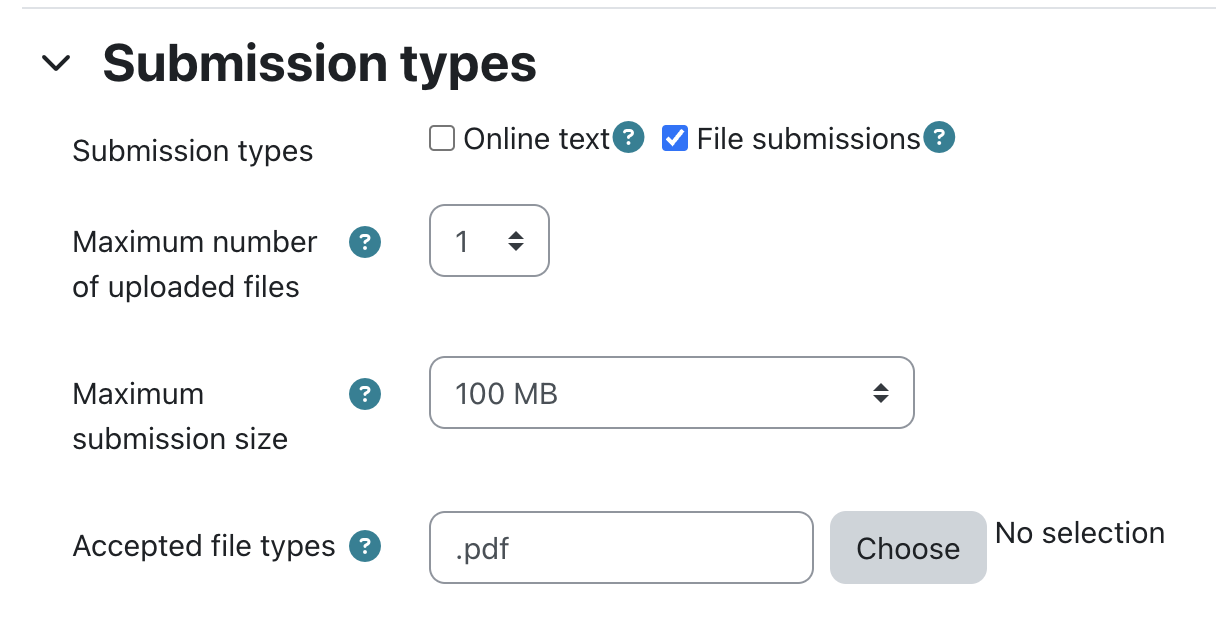
- Under Feedback Types , check Feedback Comments and Annotate PDF.

- Adjust the remaining settings as needed, then click Save and Display or Save and return to course.
To enable this feature on an existing Assignment, click the Assignment name and go to the Settings page. From there, proceed through steps #4-7.
Mark with annotate PDF
- Open the assignment in your Moodle course page for which Annotate PDF has been enabled.
- On the Assignment page, click Grade .

Note: Instructors can highlight, write, type, add stamps, and post notes in a PDF documents submitted by students when Annotate PDF is enabled. Instructors can do this on a computer, iPad, or other tablet.

- Enter the Grade and any overall Feedback Comments . A part of your written feedback, you can add files, links, short audio (microphone button), or video clips (camera button) .
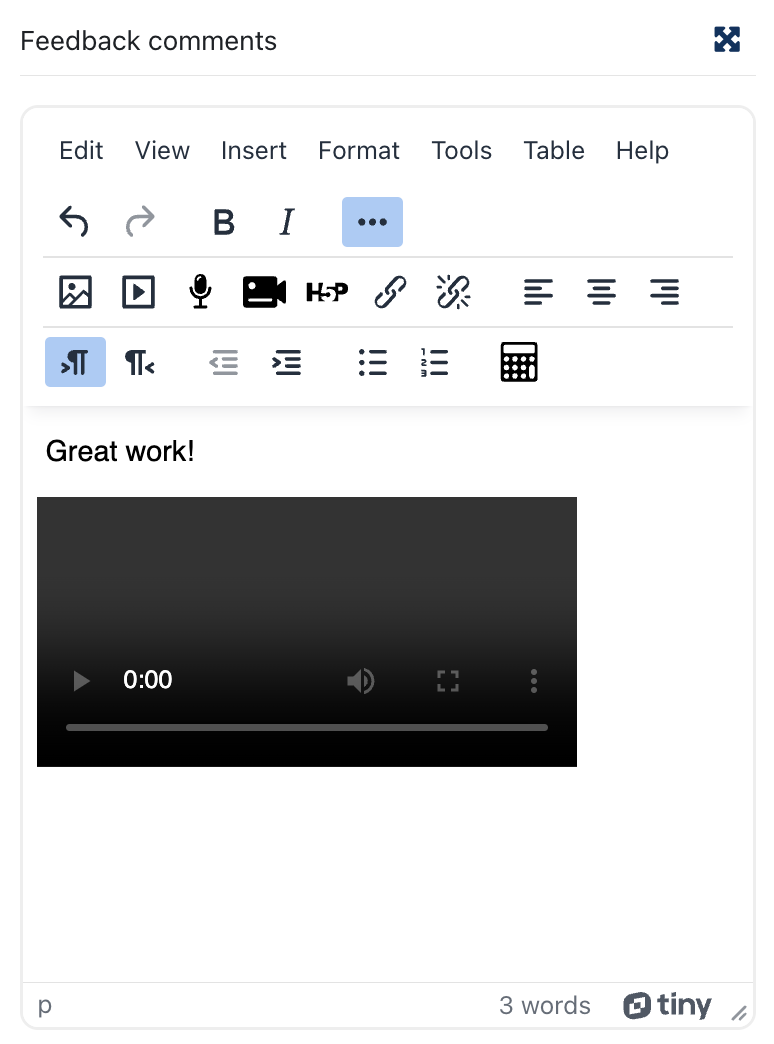
- Attach any files you want to add to your comments through the Feedback files menu.
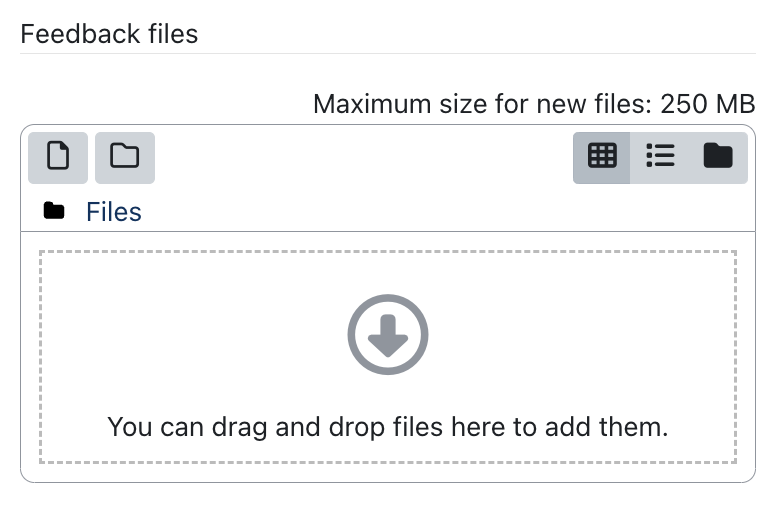
- Click Save Changes to save as you go or Save and Show Next when you are finished with a submission and are ready to proceed to the next one.
- To download a copy of any student's annotated submission, return to the Assignment page and find the Annotate PDF column. Pick the PDF you want to download and click its title. The PDF will download to your computer.
Ensure students submit good PDF's
The Annotate PDF feature only works with PDF files. If students submit files in other formats, Moodle will try to turn them into PDF's, but these conversions are unreliable. For best results, have your students save their assignments as PDF's before submission. You can also force students to submit assignments as PDF's as part of the assignment settings.
Note: Some students may not know how to save, export, or print files as PDF's. Add a link to Save a File as a PDF to your Moodle course page or assignment instructions to help.
If your students need to submit handwritten work, make them aware of the following:
- On-campus students can scan documents as PDF's using the Canon multifunction copiers.
- Free smartphone scanning apps allow students to create multi-page PDF documents using the phone’s camera. See Office Lens: Scan papers or documents with your smartphone for more information.
If you have any additional questions or problems, don't hesitate to reach out to the Help Desk !
Phone: 610-526-7440 | Library and Help Desk hours Email: [email protected] | Service catalog Location: Canaday Library 1st floor

Related Articles

Thank you! Your feedback has been submitted.
- Library and Help Desk Hours
- Web Accessibility
- Credits and Attributions
- Have feedback?
- © 2021 – Bryn Mawr College. All rights reserved.

Learning Technology & Innovation
Innovating teaching and learning with technology
- How to ‘Release’ grades and feedback in Moodle!
It’s this time of the year! Marking is in progress, and you will soon need to Release grades and feedback to students via Moodle!
Don’t forget marking workflow is enabled for all moodle assignments you need to release the grades and feedback for students.
Firstly, the Marking workflow in Moodle is a great feature. It enables teachers to add grades and feedback to student submissions and allow them to ‘Release’ (reveal the grades and feedback) at the same time for all students when they choose to do so.
How to ‘Release’ grades and feedback to students?
Considering Marking workflow is enabled for all newly created Assignments in Moodle (2019/20), you must ‘Release’ the grades and feedback to students . To do so, follow the steps below:
1. Click the Assignment link and View all assignments .
2. Scroll to the bottom of the page and under Options > Assignments per page select All to get all assignments to display on one page.

3. Select the submissions for which you want to use marking workflow using the Select box on the left of each submission – to select all submissions, click the Select all box under Select .

4. Scroll to the bottom of the page and from the drop-down menu With selected… select Set marking workflow state and click Go .

5. On the screen that appears, and from the drop-down menu Marking workflow state, select Released . You can choose to Notify students by selecting Yes to generate an email. Click Save changes .

6. Students will be able to review their grades and feedback.
N.B. If blind marking is in use with marking workflow, the grades are released regardless of whether student identities have been revealed . However, you and other markers are likely to want to reveal identities at some point. Grades are only released once student identities are revealed (updated Nov 2023). You can find the option to Reveal student identities in the Grading action drop-down menu at the top of the submissions table. You need to have Teacher (Editor) or higher access to do this.

If you experience problems releasing grades and feedback to your students, get in touch with [email protected]
Share This Story, Choose Your Platform!
About the author: athina chatzigavriil.
Comments are closed.

Follow LTI on Social Media

Subscribe to the LTI Blog via Email
Enter your email address to subscribe to the LTI blog and receive notifications of new posts by email.
Email Address
Recent Posts
- LSE to go wholly online forever, I think
- New improved LSE Moodle and lecture recording guides
- All watched over by machines of cold indifference
- Moodle Recharge & New Features
Posts by Date
Annotating Moodle Assignment Files
Annotating assignment files using built-in tools.
It’s possible to use the built-in annotation tools in Moodle to markup files submitted through a Moodle Assignment.
- On your device (e.g., iPad, laptop), log into Moodle in Safari.
- Go to the Moodle Assignment you want to add annotations and click [View all submissions].
- Click the [Grade] button beside the name of the student’s files you want to annotate.

- Add your annotations and click the [Save changes] or [Save and show next] button.
Annotating Assignment Files Using Notability
If you want to use something beyond the built-in annotation tools, many have found Notability on an iPad to be a rather intuitive way to annotate these same files.
Downloading the files from Moodle
- On your iPad, log in to Moodle in Safari.
- Scroll to the bottom of the page and be sure “ Download submission in folders ” is unchecked.
- Scroll back to the top and from the “ Grading action ” drop-down menu, select “ Download all submissions .” You should be asked to confirm you want to download the submissions.
Importing files into Notability
Unzipping the downloaded file.
- Open the Files app on your iPad.
- You should see a “ Downloads ” folder, likely under the “ Favorites ” section on the left.
- Click the zip file that was just downloaded. This will unzip it.
Importing the files in to Notability
- A subject is like a category and you don’t have to have one. However, if you’re going to do this a lot, creating at least one subject for each of your courses will help keep things better organized.
- Click the import button (it looks like a box with a down-facing arrow inside it) from the upper-right corner of Notability.
- Select “ Files ” from the drop-down menu and click “ Browse ” from the bottom.
- Click the “ Downloads ” folder and click the folder that was just created.
- Click “ Select ” from the upper-right and then click “ Select All ” in the upper-left. Click “ Open ” from the upper-right.
- Choose “ Create Separate Notes ” and click “ Next ” until you can select “ Import .”
- Annotate the files in Notability as you see fit.
Exporting, preparing, and uploading files to Moodle
DO NOT CHANGE THE FILE NAMES. Doing so will prevent the assignments from merging correctly back into the assignment.
Exporting Notability files
- In Notability , click the Export button, which looks like a box with an upward-facing arrow inside it.
- Select the files you want to export.
- Click the Export button again.
- Select “ Google Drive ” and choose where to save these files. Click “ Send to Google Drive .” Unfortunately, Notability doesn’t allow you to export to the Files app).
Creating a zip file of the exported PDFs
- Select “ Google Drive ” from the left and navigate to the folder where you exported the files. If you don’t see Google Drive listed as a Location, you may need to edit the sidebar in your Files app to toggle on Google Drive.
- Click the “ Select ” button in the upper-right and select the files you wish to upload back into Moodle.
- Click the “ More ” button in the bottom-right and choose “ Compress .” This will zip the files into one file.
Uploading the zipped file to the Moodle Assignment
- Return to Moodle in Safari, navigate to the Assignment, and click “ View all submissions .”
- From the “ Grading action ” drop-down menu, select “ Upload multiple feedback files in a zip .”
- Click the “ Choose a file ” button, click “ Choose File ,” click “ Browse ,” and click “ Locations ” so you can select “ Google Drive .” From there, navigate to the folder where you created the zip file and select it (the default name will be Archive.zip).
- Click the “ Upload this file ” button and then click “ Import feedback file(s) .” Click “ Confirm ” and then “ Continue .”
Documentation
Assignment advanced marking.
This is a proposal for additional marking features in the Assignment module.
References: https://docs.moodle.org/dev/Lightwork#User_Interface_-_Marker_allocation_and_management
Tracker Issue: http://tracker.moodle.org/browse/MDL-34902
This issue has ballooned and this spec is not longer useful. It will be broken down into smaller features with individual specs for each.
- 1.1 Control the distribution
- 1.2 Support the marking process
- 1.3 Control the release of marking to students
- 1.4 How do these functionalities combine for the user and in implementation?
- 2.1 Settings added to the mod_assign settings page
- 2.2.1 Marking release
- 2.2.2 Marker allocations
- 2.3.1 Teacher is creating an assignment with a small number of students and they do not wish to use advanced marking
- 2.3.2 Teacher is creating an assignment with a small number of students and they wish to mark all submissions, then re-mark several submissions to check for "grading drift" before release
- 2.3.3 Multiple Teachers are marking submissions for the same assignment and they want to know who is marking which assignment
- 2.3.4 A teacher has assistants helping them mark and wants to review all marks before they are released 1
- 2.3.5 A teacher has assistants helping them mark and wants to review all marks before they are released 2
- 2.3.6 Multiple markers which to separately mark the same set of students and then a moderator either takes an average or chooses one of the marks to be released
- 2.3.7 Multiple markers mark one student in sequence
- 2.3.8 Separate release of grades and feedback
- 2.4.1 Assignment settings screen
- 2.4.2 Submission menu in grading table
- 2.4.3 Batch operations menu
- 2.4.4 Marker allocation
- 2.5 Database Changes
Goals, rationale and fundamentals
The main goals of this change are to:
Control the distribution
Support the marking process, control the release of marking to students.
This is relevant in the context of large courses where groups/groupings are used to divide the students into groups and to associate dedicated staff with these groups. In terms of assignment marking the idea is that staff associated with groups are responsible for the marking of students in their groups and fulfil such marking independently from the marking of other groups.
An example would be: A course with 300 students is divided into 3 groups of students (based on different delivery locations, modes, tutorial groups, or other criteria). Two or more staff are associated with each group (one teacher and several teaching assistants). The same assignment is setup for the whole course. The staff associated with each group of students are responsible for marking their groups.
When looking at the assignment marking (mod/assign/view.php?id=3&action=grading) staff associated with a group should only see the students belonging to this group. It is not recorded which staff member is marking which students. The staff member in charge of the overall course might have a setting, which allows to see assignment marking for all students (of all groups).
This functionality is primarily of interest to the EAM project.
SW(USQ) I consider it important from an administration point of view that it is important to record which staff member is marking which student. Certainly the staff member in charge should be able to see who is marking which assignment, however I think that a setting (switch oon) to allow other persons (possibly admin staff/non teachers) t osee who is marking which student/s assignments.
The focus here is on assisting with the marking process, typically in situations where multiple teachers and/or teaching assistants form a marking team. The idea is to allow each individual marker to have an overview of marking assigned to them and of the status this marking is in. The teacher in charge of the assignment wants to be able to see how marking is progressing and what quality the marking is (per marker and across markers).
To achieve this focus two aspects need to be introduced:
- Marker allocations;
- Marking statuses.
With marker allocations, it is recorded which marker (teacher or teaching assistant) is marking which student. Only the marker allocated can mark a student. The teacher in charge of the assignment decides the marker allocation (the teacher selects all staff involved in marking and then distributes marking manually, randomly, or even based on groups). As the marking progresses, allocations can be changed (e.g., when a marker becomes unavailable).
GW - my concern with the paragraph above is that it implies that the processes of allocating manually, randomly or by groups will all operate identically. It is my understanding that the spec below is suggesting that manual allocation happens within the assignment grading table, whereas random allocation will effectively occur via the use of groups and will take advantage of the random allocation mechanisms already built into the group manager in Moodle. Likewise allocating by groups will take advantage of the same existing Moodle functionality. It was my impression that changing allocations during the marking process if groups (including random groups) are used, will require changes to the group membership. This may be a minor point, but I think it is worth highlighting.
EH - Grette, putting implementation issues aside, do you agree with the functionality proposed and importantly, with the fundamental difference to what I have called 'distribution of marking'? If we can agree on the fundamentals first we can then see how the implementation will work. What is currently described below (e.g., with the screenshots) suffers, in my opinion, from confusion about what we want to achieve.
GW - I guess I am finding it difficult to see what the difference between allocation and distribution is in reference to identifying which marker will mark which students work. I am unsure what the implications of highlighting the difference will be.
The following marking statuses are suggested:
- Allocated (the marker has not yet started)
- In marking (the marker has started but not yet finished)
- Marking completed (the marker has finished but might need to go back for checking/corrections)
- In review (the marking is now with the teacher in charge for quality checking)
- Ready for release (the teacher in charge is satisfied with the marking but wait before giving students access to the marking)
- Released (students have access to the marking.
The marking statuses are for use by staff. The marking statuses are not visible to students. The default setting will be that students can see who has marked them (but this can be changed). Marking can be taken from one status to the next on individual student basis, yet there are also bulk transitions (e.g., to release of ‘ready’ marking). Marking can be taken back into a previous status (e.g., from in review back to in marking if more work is required).
When looking at the assignment marking (mod/assign/view.php?id=3&action=grading) it is displayed who is marking which student (and only the staff assigned can edit the marking).
The functionality related to the marking process has its origins in Lightwork and is primarily of interest to the Lightwork online project.
GW - EAM are also interested in manual allocation of marking as an addition to using groups.
EH: Are you talking about manual distribution of subsets of students to individual markers/several markers (with processes like I have described in the first point about 'Distribution', or, are you talking about supporting the marking process? GW - see my comment above about not being clear on the reason for the distinction between allocation and distribution.
PC: I believe a simplified set of statuses would be good when there is only a single marker:
Multiple markers - "Allocated"->"In Marking"->"Marking Completed"->"In Review"->"Ready for Release"->"Released"
Single marker - "In Marking"->"In Review"->"Released"
SW(USQ) from our perspective, I tend to agree with PC, we need a different status set for multiple and single markers, otherwise it just causes confusion
A problem with the current Moodle assignment module (2.3) is that students can immediately see their marking results (if the teacher does not take extra steps for hiding the assignment from student view and hiding the grade book entry). This is not good, as it does not allow the teacher to make changes (e.g., as required to deal with marker drift or for checking across multiple markers).
The suggestion is to add a release control to the assignment module. This will have three possibilities, visible in the assignment marking overview screen (mod/assign/view.php?id=3&action=grading):
- Nothing shown (no-one has yet saved any marking for a student)
- Not released (someone has saved marking, but this marking is not yet visible to the student)
- Released (marking is visible to the student)
The sole focus here is on if the student can see the marking or not. This is not about trying to manage the marking process.
This functionality is already included in supporting the marking process as proposed by the Lightwork Online project. The EAM project is interested in this functionality as well.
PC: A concern that I have with adding a release control to the assignment module is that teachers already have a form of release control (hiding the grade book entry). It might be simpler if we could use this existing mechanism instead of adding a second release control that may confuse teachers.
GW - my sense is that using the hide/show controls for the gradebook entry requires teachers to move to a different part of Moodle in order to ensure that students do not receive their grades/feedback immediately. A function that sits within the assignment module itself will be more visible and hopefully therefore more usable. We should definitely not build something however that prevents teachers from using the 'hide/show gradebook entry' method.
EH: I think that the additional functionality would be well placed. Hiding marking from students needs to occur in two places: in the gradebook and in the assignment activity. Hiding the gragebook entry is fairly easy for the teacher (but, as Grette points out, it is in a different place in Moodle). Hiding the assignment activity has unwelcome side effects. As I understand it, the teacher needs to hide the assignment from student view so students cannot see marks and feedback. But, for example, this means that students cannot make late submissions (as they cannot see the assignment ...).
PC: Just to be clear, what I was talking about was using the proposed release control in the assignment settings to hide the grade book entries (not expecting teachers to move to a different part of Moodle). In other words, when an assignment is created with release control, it would be automatically set to 'hidden' in the grade book.
How do these functionalities combine for the user and in implementation?
The functionalities would result in three settings to the Assignment update page (course/modedit.php?update=3&return=1).
- Control release of marking to students (Yes/No)
- Set distribution of marking (Yes/No; with Yes offering selection of groups/groupings)
- Manage marking process (Yes/No; with Yes offering allocation algorithms/manual allocation)
Controlling the release of marking to students is not in conflict with setting the distribution of marking, and is already included in managing the marking process.
Fundamentally there is no conflict between setting the distribution of marking and managing the marking process (in fact, it would be welcome as a ‘group’ will likely contain a large number of students and possibly several markers, making it very useful to be able to manage their marking). Yet, an initial implementation might keep things more simple and make these setting mutually exclusive.
The distribution of marking will build on already existing groups and groupings. No further database tables should be necessary to capture this information. Any changes to groups would be reflected during the marking process.
Capturing the marking allocations will require new database tables. If one allows building the allocation on groups, this will mean that the initial setting for the allocations is taken from the groups, but that any changes to groups will not be automatically reflected in marker allocations (but can be done manually, like any changes to allocations). GW - this would be highly problematic for groups that get their membership from Student Information Systems.
(The following sections currently do not match what is proposed under Goals above.)
Settings added to the mod_assign settings page
Release grades immediately (Checkbox, default to on - this is the current behaviour)
[Help text] When enabled, grades will be visible to students as soon as they have been entered by a grader (If the grade column is visible in the gradebook). When disabled, any grades that are entered will be only visible to graders until they are approved for release.
Allocate markers to students (Select list of options, "None - all markers can mark all students", "Manually allocated - markers are manually allocated students to mark", "Groups - Markers can mark students in their own group")
When the grouping method is chosen above, an additional setting should be enabled to allow a grouping to be specified for the marker allocations.
Grouping for marker allocations (Select from the available groupings - or None for all groups)
GW - we currently create marking groups using the groups interface and then set assignment up using "Separate groups" so that markers can filter the list of assignments. One of the issues we have come up against is unenrolled (suspended) students still appearing in the groups interface. We have a proposal for better management of suspended users. We have identified 23 (possibly 25) areas where suspended users are currently an issue. Where possible, we’d like an option to toggle between hiding and showing suspended users, with the default option being hidden. We are looking to resource a change that will be all encompassing and a complete fix that can be contributed back to the Moodle community. Initially we will build for 2.1.6, but will then review for 2.3 towards the end of the year.
PC - I believe the assignment settings should be simplified or teachers will find it confusing. I would like to see the "Release grades immediately" and "Allocate markers to students" replaced with a single drop down of standard options:
- Simple marking" (the default settings - grades are released immediately)
- Advanced marking - single marker" (Grades are released when status changed to 'Released')
- Advanced marking - multiple markers" (Grades are released when status changed to 'Released')
Note that when choosing "Advanced marking - multiple markers" the teacher would be able choose whether or not to use a Grouping for allocating markers. If we are going to allow other combinations of "Release grades immediately" and "Allocate markers to students" then we could have an additional menu item to allow teachers to choose their own combination.
EH: Paul, with "Advanced marking - single marker", do you see that an automated marking allocation is made to one person (who has to have the capability to release grades), therefore enforcing that only this person can mark? I think this is a quite different approach to what Damyon is proposing, which basically says 'use marking statuses but do not record/control who is marking'. If I understand correctly what Paul is proposing, this means that one can use marking statuses only if one controls marker allocation. This might be a better solution, as it cuts out variety, simplifying things for the development and the user. We could add a fourth option for using marking statuses without marker allocation, this might give the following options:
- Simple marking" (the default settings - grades are released immediately, marker allocations are not recorded)
- Advanced marking - no marker allocations" ((Grades are released when status changed to 'Released'. No control who is marking)
- Advanced marking - single marker" (Grades are released when status changed to 'Released'. Only single marker specified can mark and release)
- Advanced marking - multiple markers" (Grades are released when status changed to 'Released'. Multiple markers work together)
GW - I think my preference is for three settings: Release grades immediately Allocate markers to students
and the third Grouping for marker allocations (to appear only if group allocation is selected)
I think it may end up being clearer, rather than trying to explain in help text what Simple marking and the Advanced marking options are.
PC - My concern is that being able to choose a combination of settings in this way does not make it clear to the teacher what they will end up with at the end. For instance, a teacher who wants to take advantage of the advanced marking process should not have to work out that they have to select "Release grades immediately - No" in order to do this. Also, see my comment earlier about the use of the "hiding" facility in the grade book to control the release.
Changes to grading/grading interface
Marking release.
If "Release grades immediately" is not enabled, an additional status should be added to the grading status column "Draft/Ready for release/Released". Use background colors as well to visually distinguish the statuses (Blue - draft, Fushia - Ready for Review, Yellow - Ready for Release, Green - Released).
Anyone with mod/assign:grade capability would be able to move the status from "Draft" to "Ready for Review" via the drop down menu on each submission, or via the batch operations form.
Anyone with mod/assign:releasegrade (new) capability would be able to move the grade from either "Draft" or "Ready for Review" to "Ready for Release".
Anyone with mod/assign:releasegrade (new) capability would be able to move the grade from either "Draft" or "Ready for Review" or "Ready for Release" to "Released". At this point the grade is pushed to the gradebook and made visible to the student.
Marker allocations
If "Allocate markers to students" is set to "Manually allocated", and the current user has "mod/assign:allocatemarkers" capability, the list of markers allocated to each student needs to be shown in a new column in the grading interface.
Multiple markers should be able to be allocated to a single student. (GW - future dev? Implies the need for markers to be able to lock assignments while they are marking them). If the current user has mod/assign:allocategraders permission, a red X next to each markers will allow immediately removing this marker (Ajax if possible - don't refresh the full page) An option should be added to the menu for each submission and the batch operations menu which takes you to a separate page where you can choose from the users with mod/assign:grade permission to allocate to a student (or multiple students).
Any student with no markers allocated should have "No markers" in this column and the column background should be shown in a different colour (Red?) to indicate that no-one has been assigned to mark this submission. If the current user has "mod/assign:allocatemarkers" and "mod/assign:grade" capability, there should be an entry in the menu for this submissions for "Assign to me" (preferably AJAX - do not refresh entire page).
If the a submissions has not been allocated to the current user, the option to grade that submission is removed.
If the current user does not have "mod/assign:allocatemarkers" capability, the list of submissions will be limited to only show the submissions where the current user has been allocated as a marker.
PC - How will you be handling marker allocation in the database when "Grouping for allocating markers" isn't selected? Answer from our last meeting : marker allocation tables will be used
Teacher is creating an assignment with a small number of students and they do not wish to use advanced marking
- Release grades immediately: "checked"
- Allocate markers to students: "None"
Teacher is creating an assignment with a small number of students and they wish to mark all submissions, then re-mark several submissions to check for "grading drift" before release
(I am defining this as the perception of quality changing over time as the marker marks each assignment in turn - can't find a good reference right now) EH: This is called 'marker drift'. you'll find a brief description in http://etools.massey.ac.nz/documents/LitReview101006.pdf (p. 19 bottom), as well as references to further literature.
- Teacher has "mod/assign:create", "mod/assign:grade" and "mod/assign:releasegrades" capabilities
- Release grades immediately: "not checked"
- Teacher marks each submission individually. Grades are "Draft" and not released to gradebook or students
GW - I think I know why this status is "Draft", but I think it might get confused with the submission status in the interface. I think we can come up with a better term..not that I have thought of one yet.
PC - How about "Provisional"?
- Teacher re-marks a random sample of submissions
- Teacher releases all the grades via the batch operations form
EH: The seems to be our 'In marking'
GW - what about "Ready to mark" - this might be more consistent with the other statuses "Ready for review" and "Ready for release". Is there any relationship between this status and the submission status...ie. if the submission status is "Draft" should the marking status be "Not ready to mark", which changes to "Ready to mark" when the submission status is "submitted"?
'Not marked' 'In Marking' (?) 'Ready for review' 'Ready for release' ' Released'
I think we should point out as the main reason for the stepped release of grades via the transition from 'Ready for release' to 'Released' as
- The teacher wants to release marking to all students at the same time.
Marker drift or any other checking done by one person on their own marking is important. Yes, in this use case the teacher can use the statuses proposed for that, yet the need for this type of checking applies to all markers (teachers and teaching assistants). This is why we have proposed the statuses of 'In marking' and 'Marking finished', before the marking is being passed on the the teacher for further quality review (e.g., to check across markers).
PC: I believe the following statuses would be good:
PS: The descriptions here focus on the release of grades - this portraits a very summative viewpoint; it does not acknowledge the importance of feedback (as in the comments hopefully written to guide the students). This is why I tend to talk about marking and marking results.
Multiple Teachers are marking submissions for the same assignment and they want to know who is marking which assignment
- Assignment has been created and there are multiple markers with "mod:assign/grade and mod:assign/allocatemarker" capabilities
- Each marker selects "Assign to me" for the submissions they wish to mark.
- Each marker then provides grades and feedback which is released immediately to students
- The markers can see which students have been allocated a marker and will not end up marking the same student
A teacher has assistants helping them mark and wants to review all marks before they are released 1
- Assignment has been created and there are is a teacher with "mod/assign:grade", "mod/assign:allocatemarker" and "mod/assign:releasegrades" capabilities
- There are multiple teaching assistants who have "mod/assign:grade" capability but not "mod/assign:releasegrades" or "mod/assign:allocatemarker" capabilities
- Release grades immediately : not checked
- Allocate markers to students : Manually
- The teacher allocates a set of students to each of the Teaching Assistants
- The teaching assistants login and can only grade their own students. The grades and feedback are "Draft" and not released to gradebook or students
EH: It would be nice to have an option on the settings page where the teacher can set if the Teaching Assistants can see the marking done by other markers (not just the grade). Is the current proposal that a Teaching Assistant would see the entries for students not allocated to them (that means that can see the grade given by another Teaching Assistant)? There would have to be a 'read-only' grading option, allowing the Teaching Assistant to view marking done by others but not change it. DW: No the current proposal is that they would not see any students not allocated to them.
- When finished, for each submission the teaching assistant changes the status of the grades to "Ready for review"
EH: Here it would be nice if the Teaching Assistant could pass on a message to the Teacher together with the status change.
- The teacher can see which grades/feedback are ready for them to review by the grading status.
- The teacher reviews all grades and feedback that are "Ready for review", making changes if necessary
EH: How will the screenshot look? Will the Teacher have access to the grading interface even if the Teacher is not allocated to mark (the Teacher will have to look at the marking details, not just at the grade)? DW: yes they would see the grading interface If the Teacher changes feedback or grade, will this mean an automated re-allocation to the Teacher as marker? DW: The teacher would not be able to provide grades or feedback unless they were the allocated marker Will the student see who has marked them (there probably should be a setting allowing the Teacher to decide)? DW: This is a big change - it would currently show them the last person to mark them. We also need to options here to return the marking to the Teaching Assistant (ideally with comments, explaining why) and to allocate another marker (who then will continue with the marking already started - maybe this is already covered). DW: This is quite an advanced workflow - we need to make sure we are not adding too much complexity (it is not prevented by this interface - it just does not include any statuses for it - ie "Needs allocation to another marker for a second round of marking")
EH: This description skips the step of the Teacher taking assignments into 'Ready for release' after successful quality checking.
- The teacher changes the status of the grades to 'Released' when they are satisfied with the grading quality.
EH: I think this should read: The Teacher changes the status from 'Ready for review' to 'Ready for Release' when they are satisfied with the grading quality.
Then the next step is: The Teacher changes the status from 'Ready for Release' to 'Released' when they want to release marking to students.
DW: I have added the "ready for release" status - but this will require good help explaining the difference between the statuses to teachers. A visual flow chart of the statuses would help.
GW - I think that the Teacher should have the option to skip the "Ready for Release" status and take the assignment from "Ready for review" straight to "Released". If statuses can be skipped..ie. as long as we don't force users through every status, then i don't think it will be a problem to have the five statuses as proposed above: 'Not marked' 'In marking/Being marked' 'Ready for review' 'Ready for release' 'Released'
PC - I don't agree with skipping the "Ready for Release" status since it is an important part of the review process. However, it is possible to make the switching between statuses fast and efficient by having bulk options such as "Release all" that automatically selects marking with one status and moves it to the next.
Where it would be appropriate to reduce the number of statuses (but possibly not in our first Moodle 2.4 release) is when there is only a single marker. So, I think we need the following:
A teacher has assistants helping them mark and wants to review all marks before they are released 2
- There are groups containing teaching assistants and sets of students contained in a grouping.
- Allocate markers to students : Groups
- Grouping for marker allocation : "Name of Grouping"
- The teacher changes the status of the grades to "Released" when they are satisfied with the grading quality.
If there are multiple markers added to a group then all markers will be able to mark assignments in that group.
GW - If there are no markers in a group, then there is the potential that student assignments would get missed....there is no visual queue that students are unallocated. In addition - our SIS-created groups systematically check for the addition of members who are not in the group in the SIS. Any staff therefore who are added to the groups in Moodle will be removed from the group on the next update...unless we changed our integration script to retain users in SIS-created groups as long as they were not students??
Multiple markers which to separately mark the same set of students and then a moderator either takes an average or chooses one of the marks to be released
Not supported by this proposal
Multiple markers mark one student in sequence
EH: This is about two or more markers marking student work, e.g., marker 1 marks parts 1 and 2, marker 2 marks parts 3 and 4 of an assignment. This could be done with a different form of allocation: marker1 picks a student and then marks their part; the interface shows that marker 1 has done their part, marker2 can now allocate themselves and continue the marking. Once all markers involved (as setup initially, here markers 1 and 2 need to mark) have done their parts the status changes to 'ready for review'.
This is not part of the current proposal.
Separate release of grades and feedback
EH: It would be nice to be able to release feedback (for formative purposes) first and marks/grades later (with a time delay or triggered by the Teacher, or, more sophisticated, dependent on the student doing something).
DW: I think it should be - but I don't what to make it complicated. I think that either the feedback is visible to the student during the entire marking process and they get the grade at the end - or they see nothing and they get the grades + feedback at the end (we could add those 2 options to the settings page). Note: The submission comments are visible to staff and students for the entire duration and provide 2 way comments between students and staff.
GW: The potential issue with this is that feedback might change during the marking process. Is a student-triggered process (ie. viewing the feedback) to release grades "complicated"?
EH: I am with Grette there - feedback should only be visible to students when marking is considered as finished (otherwise we would be back to the current deficiencies in Moodle)
User Interface
Assignment settings screen.
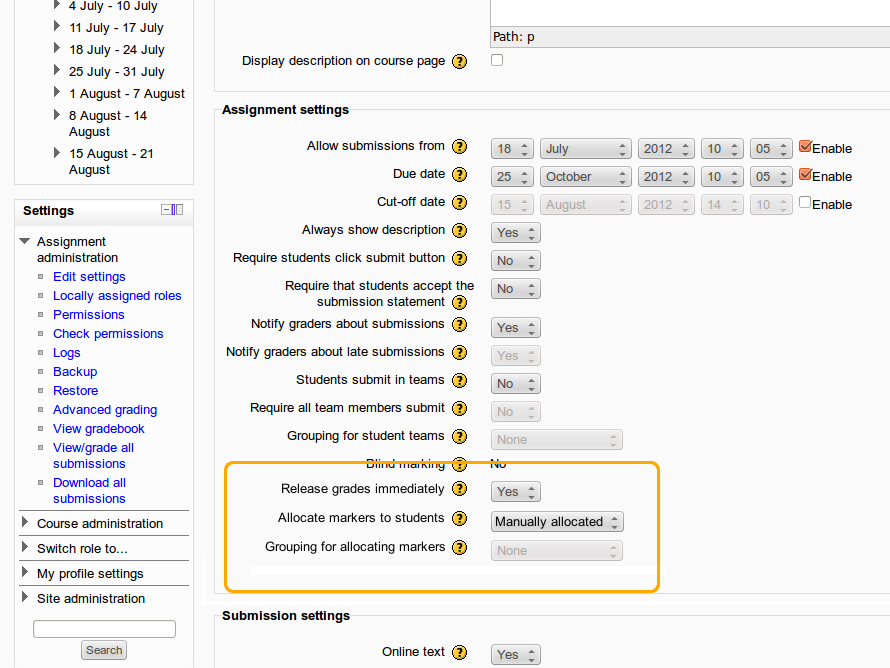
Submission menu in grading table
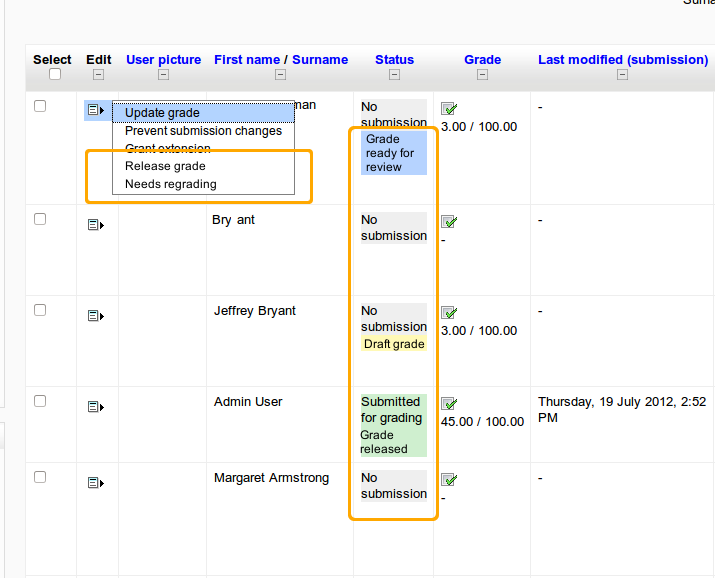
Batch operations menu
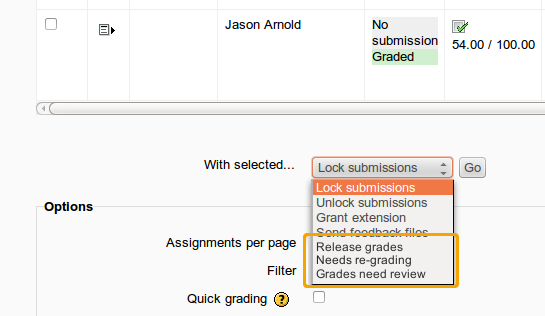
GW: Will there be an option for the Teacher with "mod/assign:releasegrades" capability to take all assignments that are in "Ready for Review" to either "Ready for Release" or "Release" without having to individually select them?
GW - will there be a batch operation for "Assign to me?"
Marker allocation
Notes: The current user is "Grader Gary" so the grade option has disappeared for all submissions that this user is not assigned to mark. The current user also has permission to assign graders so they see additional options in the submission menu.
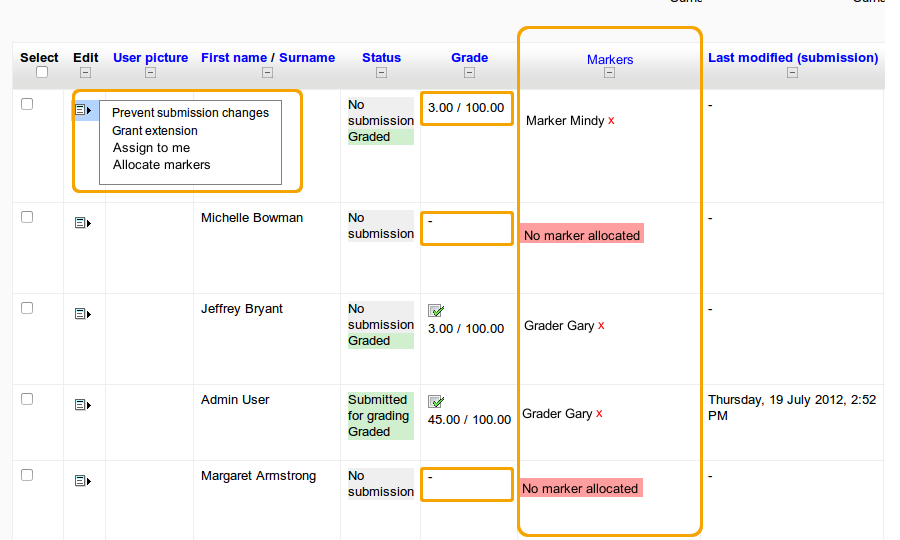
Database Changes
skip to content
Search Google Appliance
Information technology, services at a glance.
- Instructional Technologies
- Network Connectivity
- Online Storage & Collaboration
- Web Hosting
- Classroom Technologies
Control Visibility of Grade Items in Moodle
We're taking you to an updated version of this article..
UMass Amherst Information Technology support articles are now updated in the new IT Knowledge Base. We found an updated version of this article, so we're sending you there.
Taking you to:
Stay here to view this page in the legacy Support Center . Information may be outdated as these articles are no longer maintained.
Find answers to your tech questions in the new IT Knowledge Base .
UMass Amherst Information Technology support articles are now updated in the new IT Knowledge Base.
This article is part of our archived legacy Support Center and may be outdated or inaccurate . We did not find an updated version of this article. That means this archived content is more likely to be outdated or no longer relevant. Check the new IT Knowledge Base for updated information:
More tech help options
On This Page:
Manually hide grades for an entire assignment or activity, release grades at a scheduled time.
Moodle allows you to delay the release of students' grades manually, or at a scheduled time. This can be useful if you are grading assignments over a series of days and want all students to see their grades only after all grading has been completed.
- From the Course Management panel, under Grading, select Gradebook setup . The gradebook will open to the Gradebook setup .
- In the row for the grade item or category you wish to hide, under the Actions column, click Edit , a drop-down menu will appear. From the drop-down menu, select Hide . The grade item's color will be dimmed to indicate the item is now hidden.
- When you are ready to show the grades for this grade item to students, navigate back to the Gradebook setup page and locate the grade item you want to show. Under the Actions column, click Edit , and from the drop-down menu, select Show . The grade item will change back to its original color to indicate the item is now visible.
Additional Considerations for Hiding Grades
Keep in mind that when you hide a Moodle Assignment column in the gradebook, the grade is hidden throughout your course page (even when the student looks at their assignment submission). Although the grade (as well as any feedback comments or files you have added) will be hidden, the assignment activity link will still be visible.
Note : When you hide a Turnitin assignment grade in the gradebook, students can still see the grade in the My Submissions tab of the Turnitin assignment (as long as it is past the post date). For more information, see Turnitin in Moodle - an Overview .
Another option is to set grades for a particular assignment to automatically become visible to students at a scheduled time.
- From the Course Management panel, under Grading, select Gradebook setup . The gradebook will open to the Gradebook setup .
- For the grade item for which you wish to set a release time, under the Actions column, click Edit , then from the drop-down menu, select Edit Settings . The Edit grade item page will open.
- Under the Category total heading, click Show more... . Additional options will appear.
- For Hidden until , select the Enable check box. The date/time fields will become editable.
- Set the date and time for when you want the grades to be released.
- Click Save changes to finish. You will be returned to the Gradebook Setup page.
Related Topics
Get it help.
Ask an expert at the IT Service Desk.
IT Service Desk Thanksgiving Recess Hours
- Wednesday, 11/22 and Friday, 11/24 : Email/chat, phone, and in-person support available 8:30 a.m. - 5 p.m.
- Thursday, 11/23 : IT Service Desk closed
- Email and Chat Support 8:30 a.m. - 9:45 p.m. Monday - Friday 10 a.m. - 10 p.m. Saturdays & Sunday
- Phone Support | 413-545-9400 8:30 a.m. - 4:45 p.m. Monday - Friday
- In-Person Support ( Campus Center ) 8:30 a.m. - 7:45 p.m. Monday - Friday No appointment necessary. Walk-ins and calls accepted until 15 minutes before closing.
- Computer, Phone & Other Device Repairs
Add Capability for Double Marking of Assignments
- Resolution: Unresolved
- Fix Version/s: None
- Affects Version/s: 3.7
- Component/s: Assignment
- MUA_JUL_DEC_18
- MUA_JUL_DEC_19
- Affected Branches: MOODLE_37_STABLE
Description
Add capability for double marking of assignments. Some ideas for the functionality of this featuer could be taken from the coursework plugin:
https://docs.moodle.org/35/en/Coursework_module
The following video shows the double marking feature:
https://rvc.cloud.panopto.eu/Panopto/Pages/Viewer.aspx?id=eecd19fc-4298-482f-a747-a8a5014e63bd
https://www.youtube.com/watch?v=sJiTZRO8Itk
The issue with the "coursework" plugin is it does not support all assignment types, it would be far better if this were a core features. Double marking is in use or desired by many Universities.
When enabled Marker Allocation would allow assigment of both marker one and marker two.
When Marker Allocation is not in use teachers could grade assignments freely either as marker one or marker two.
Blind Marking should also be supported as it is now showing only participant ID of students when enabled up until the option to "reveal particiapants" is shown.
The assignment settings should allow:
1) Double marking to be enabled / disabled
A simple setting in the assignment itself to enable / disable
2) The grading method to be selected, suggestions for this would be:
- Highest Grade
- Lowest Grade (cannot think why anyone would do this but it would add flexibility)
- Marker One Grade (where the first markers grade is accepted and the second markers grade is only used to identify outliers - see "tollerance for outliers" section below)
3) Tollerance for Outliers
There should be a setting where a % tollerance can be set for outliers. The purpose of this is to flag assignments where the difference between grades from marker one and marker two are greater than x%.
This would allow any assignments where there is a large disparity between maker one and marker two grades to be flagged for further review / investigation.
It would also allow the use of "Marker One Grade" as the calculation where the "marker two" grade is used ONLY for quality assurance and to identify potentially problematic grades as opposed to being part of the final grade given to students.
4) Automatic Allocation of Marker Two for QA
It would be useful to automatically assign Marker Two x% of assignments to check using Marking workflow.
The purpose of this feature would be to assign a second marker to ONLY 10% of assignments for quality assurance. Thus 10% of assignment would be randomy selected for a second marker to grade.
Used in conjunction with the "Marker One" grading calculation and "Tollerance for Outliers" this would provide a mechanism for quality assurance rather than being used to provide additional grades and feedback for students.
4) Show Marker Grades or Only Final Grade
Determine whether the students can see individual grades (marker one 60%, marker two 70%, final mark 65% (if mean were the calculation method chosen).
This would allow teachers to show only the final grade for simplicity or show both grades and the final calculation for students.
Regardless of whether both grades are shown feedback from both tutors should be displayed UNLESS the "Marker One" calculation is being used for QA purposes.
As an Administrator I would like to:
- set the default assignment setting for "enable double marking"
- lock the default assignment setting for "enable double marking"
- set the default grading calculation (highest, mean etc)
- lock the default grading calculation
- set the default for showing marker grades / only final grade
- lock the default for showing marker grades / only final grade
As a Teacher I would like to:
- enable / disable double marking as required (assuming it is not locked by the administrator)
- set the grading calculation (highest, mean etc assuming not locked by admin)
- set whether students can see only the final grade or the individual marker one, marker two grades and final calculation
- use all feedback options regardless of whether I am marker one or marker two, thus both tutors shoudl have the ability to leave feedback files, feedback comments, annotation
- use advanced grading / rubrics regardless of whether I am marker one or marker two
A teacher should be be able to allocate grading activity to other tutors via Marking Workflow, i.e. allocate both Marker One and Marker Two using marker allocation.
As a Student I would like to:
Be able to view released grades and feedback as usual. Depending on what Teachers have chosen to display I may see marker one grade, marker two grade, total calculated grade OR I may only see the final grade.
As a student I always want to see feedback from both marker one and marker two regardless of whether I can see the individual marker one, marker two grades
Attachments
Issue links.

COMMENTS
Preparing to grade an Assignment Moodle grading interface overview Moodle has a built-in grading interface that allows you to annotate student assignments, add summary comments and award marks. Student submissions are displayed in PDF form and include a link to the Ouriginal similarity report (where activated). The image below gives an overview of the built-in...
The first step to using the marking workflow is to enable it on your assignment activity. This setting can be found in the Grade Section. The default for "Use marking workflow" is No, change ...
About Press Copyright Contact us Creators Advertise Developers Terms Privacy Policy & Safety How YouTube works Test new features NFL Sunday Ticket Press Copyright ...
In this video we demonstrate how to grade an assignment in Moodle.
Adding an assignment. Go to the course where you want the assignment; turn on the editing, and in the section you want the assignment, click 'Add an activity or resource'. From the Activity chooser, click the Assignment button and click 'Add'. (If you want to edit an existing assignment, click the Edit link to its right and choose the action ...
The gradebook automatically compiles the results of graded Moodle activities. Entries in the gradebook are always numeric so Moodle can simply aggregate grades automatically. Although this can be changed in the Assignment options for each activity, the default rating for each activity is 100.
This video is a part of a 21-video course for beginners teaching on Moodle. If you are new to teaching on Moodle and are looking for quick lessons on how to ...
The new interface will convert student submissions to PDF so that you can view and annotate assignments on your desktop in addition to entering grades and feedback. The built-in grading function in Assignments allows the grader to: Make annotated comments directly into the file, which Moodle automatically converts to a pdf. Give short, general ...
When the grader provides only a final grade and feedback to students, is the most commonly used grading method for a Moodle Assignment. Rubrics or marking guides are recommended for high-stakes tasks, but simple direct grading is great for smaller assignments. It takes very little time to set up and enables grading assignments quickly using the ...
To enable this feature on an existing Assignment, click the Assignment name and go to the Settings page. From there, proceed through steps #4-7. Mark with annotate PDF. Open the assignment in your Moodle course page for which Annotate PDF has been enabled. On the Assignment page, click Grade. Submissions will open one at a time in an annotation ...
Moodle Assignment: assessment with marking guides In this type of grading, the teacher defines a series of criteria and assigns a maximum amount of marking points to each. When assessing learners' assignments, the teachers provide both a numerical mark and a comment for each of the criteria. For this type of grading, you can make the criteria ...
Grading workflow and Grading allocation for Moodle Assignment activities are especially useful for large classes and classes with more than one instructor or TA.These features can be used either in conjunction with one another or independently. Grading workflow allows instructors and graders (e.g., TAs) to track preset grading stages for each student's Assignment submission.
Selecting Marking guide. Create an assignment, and in the Grades section, choose from the Grading method drop down menu the Marking guide option:; Creating a new Marking guide. When the assignment has been created and Marking guide selected as above, click Save and display and choose Define new grading form from scratch (See section 5 for information on how to use a template.)
Firstly, the Marking workflow in Moodle is a great feature. It enables teachers to add grades and feedback to student submissions and allow them to 'Release' (reveal the grades and feedback) at the same time for all students when they choose to do so. ... Considering Marking workflow is enabled for all newly created Assignments in Moodle ...
On your device (e.g., iPad, laptop), log into Moodle in Safari. Go to the Moodle Assignment you want to add annotations and click [View all submissions]. Click the [Grade] button beside the name of the student's files you want to annotate. To reveal the annotation tools, click the [Collapse grade panel] button, which is the far-right blue ...
Moodle Assignment can handle independent ('blind') marking because it allows inboxes of submissions to be downloaded (preserving anonymity if needed) along with a marksheet. Similarly Moodle Assignment can handle offline marking by allowing submissions and marksheet to be downloaded, preserving anonymity if needed.
Plan for marking and grading Plan for marking and grading. Ensure consistency and quality in marking Ensure consistency and quality in marking. Calculate late penalties Calculate late penalties. Address unconscious bias in teaching and assessment Address unconscious bias in teaching and assessment. Supporting your students.
2.3.1 Teacher is creating an assignment with a small number of students and they do not wish to use advanced marking. 2.3.2 Teacher is creating an assignment with a small number of students and they wish to mark all submissions, then re-mark several submissions to check for "grading drift" before release.
The View/grade all submissions page for a Moodle assignment activity allows you to do several important grading functions. Grades entered on this page will appear in the corresponding grade column of the gradebook. We recommend grading Assignments from this page, rather than manually entering grades in the Grader report, especially if you want to provide feedback as online
! 3! Group!Submission!Settings!! **Group*Work-!you!can!now!have!students!submit!work!as!a! group.!One!member!can!submit!on!behalf!of!the!entire!group! and!the ...
Note: Marking workflow is enabled by default on all assignments but can be changed in Assignment SETTINGS. Step 2: Set Marking Workflow state Tip: Click on the question mark icon next to any setting to display extra help or click on Moodle Docs for this page link at the bottom of each page in Moodle for accessing context-specific documentation.
From the Course Management panel, under Grading, select Gradebook setup. The gradebook will open to the Gradebook setup. In the row for the grade item or category you wish to hide, under the Actions column, click Edit, a drop-down menu will appear. From the drop-down menu, select Hide. The grade item's color will be dimmed to indicate the item ...
Marking Guide Report. The Marking guide grading report plugin allows teachers and managers to drill down past a student's overall advanced graded mark received, and to view all their students' grades and comments for all the criteria from the relevant marking guide used for advanced grading. When an assignment or forum is graded using a ...
The assignment settings should allow: 1) Double marking to be enabled / disabled. A simple setting in the assignment itself to enable / disable. 2) The grading method to be selected, suggestions for this would be: Highest Grade. Lowest Grade (cannot think why anyone would do this but it would add flexibility)